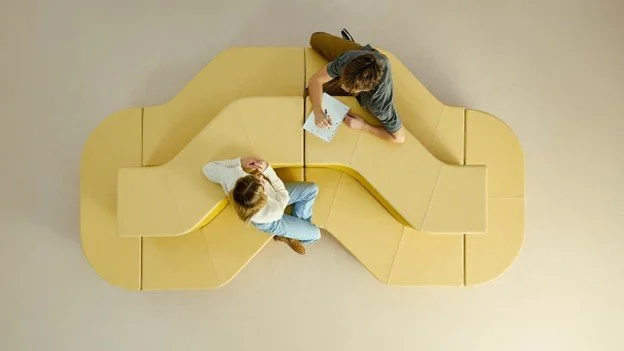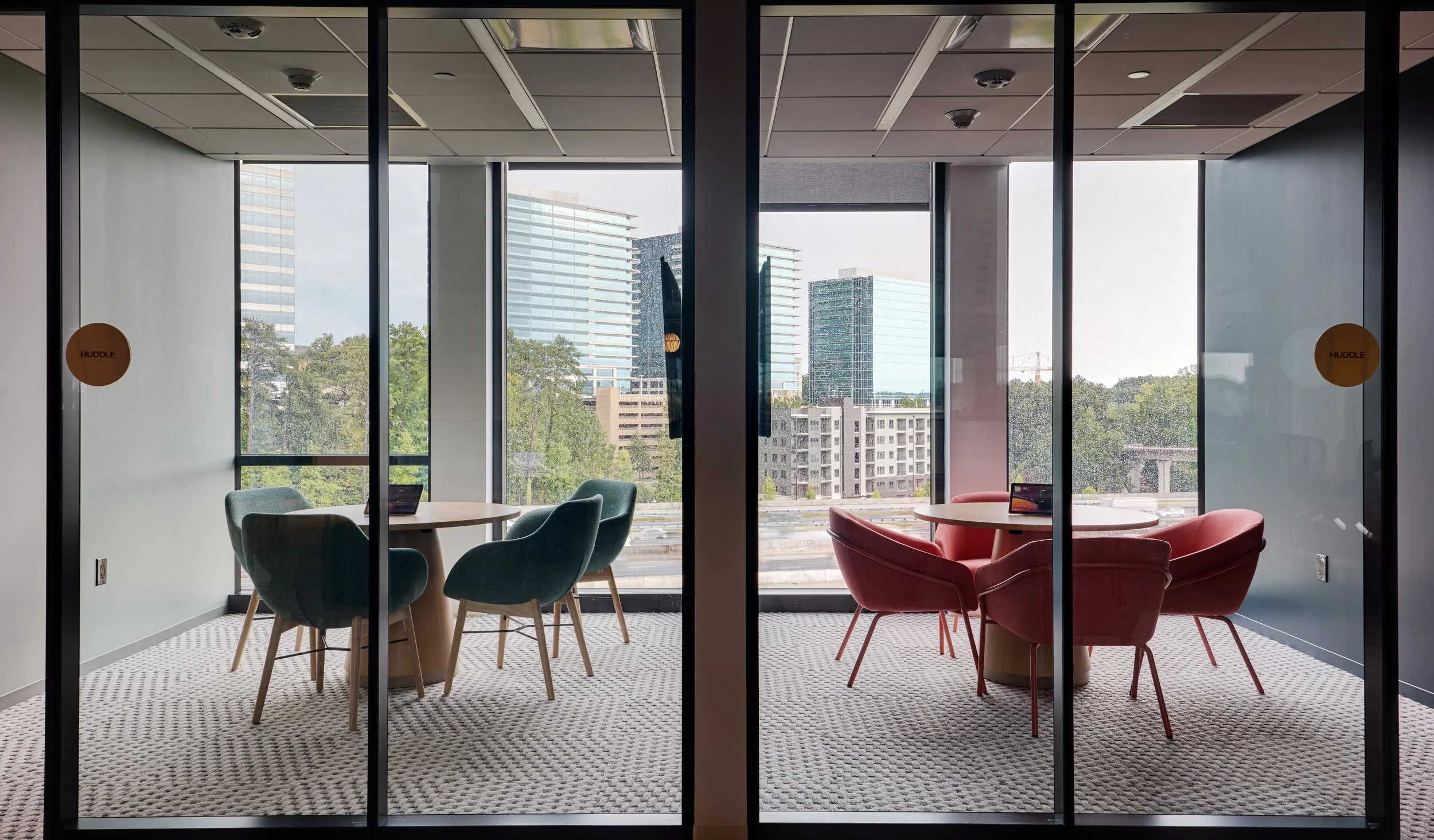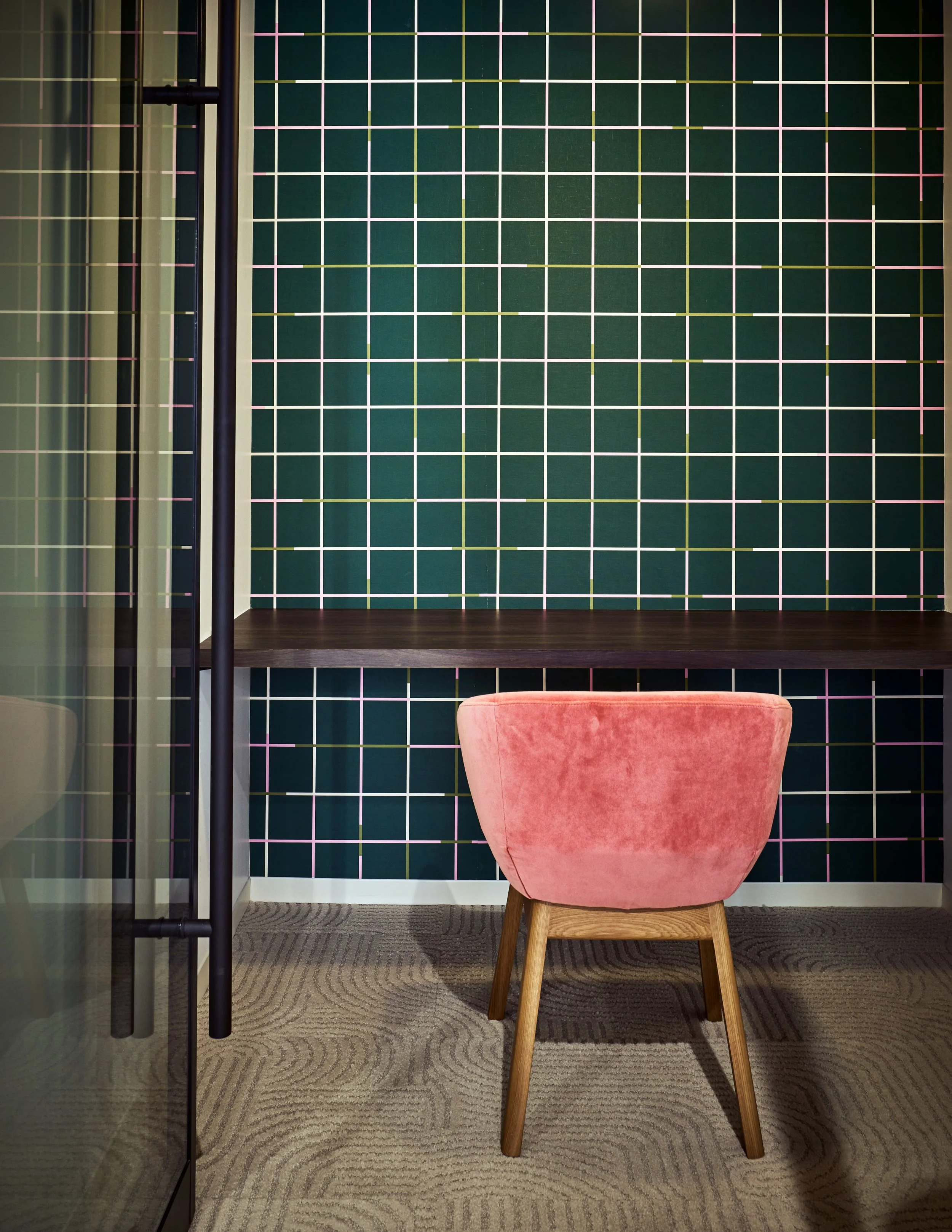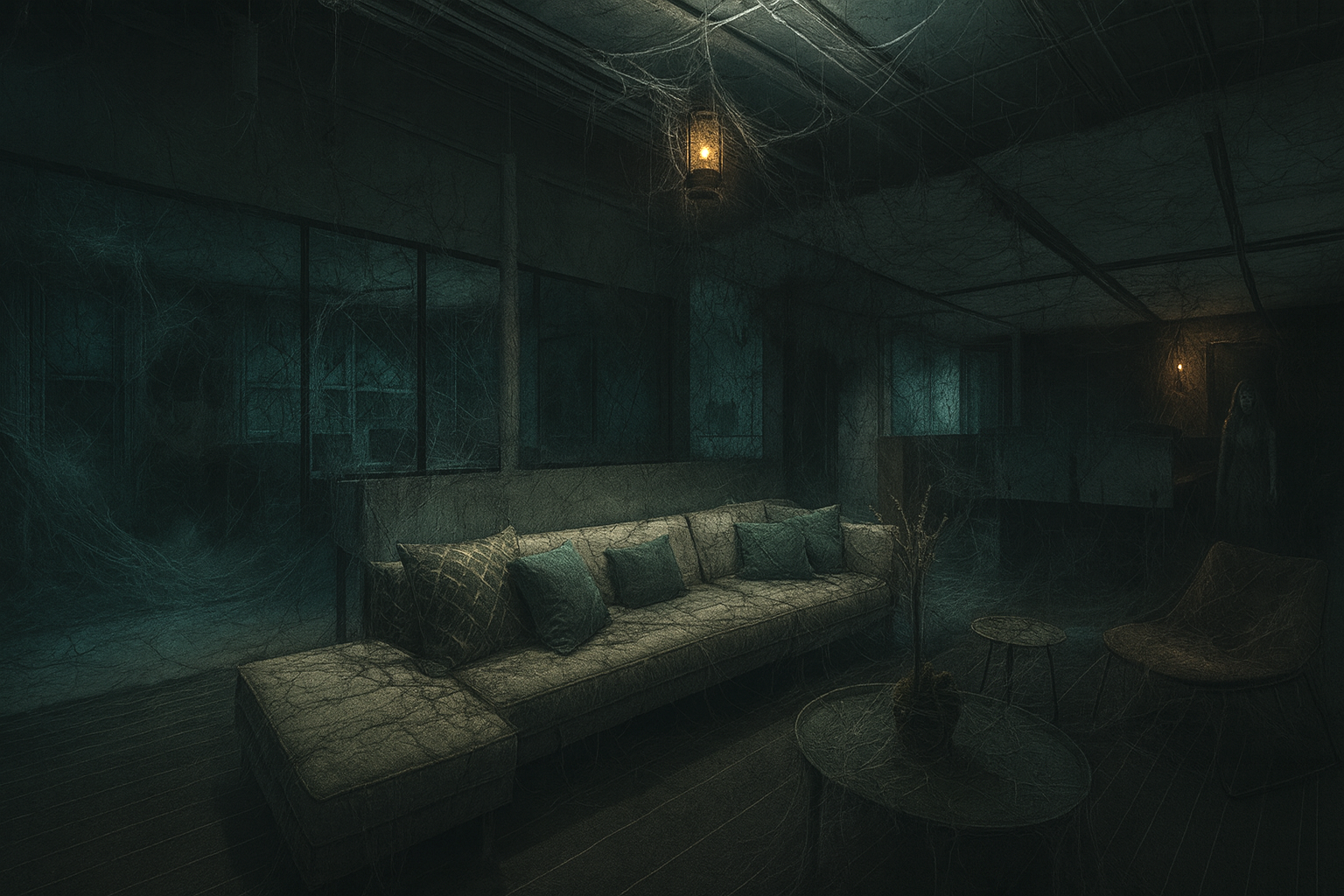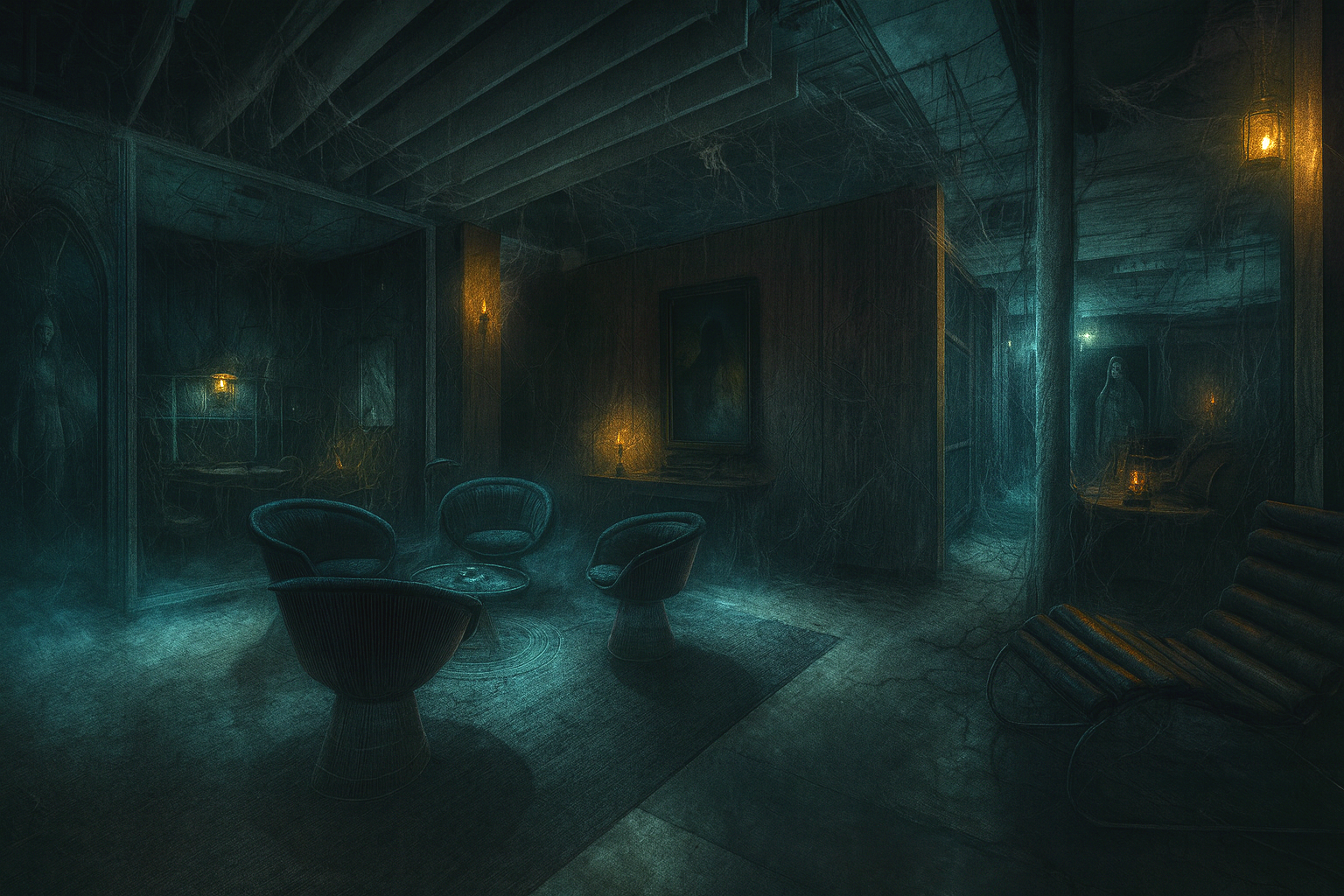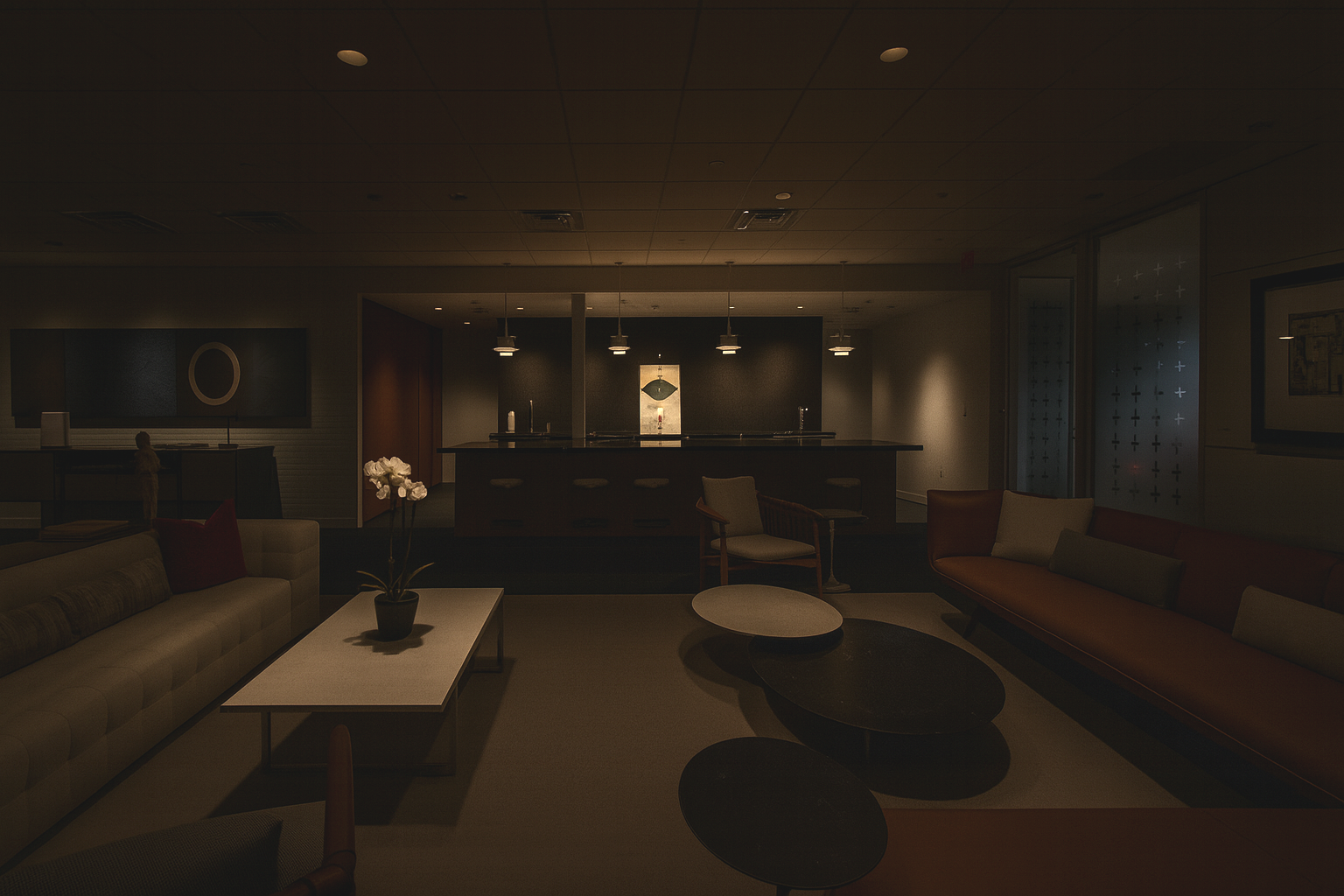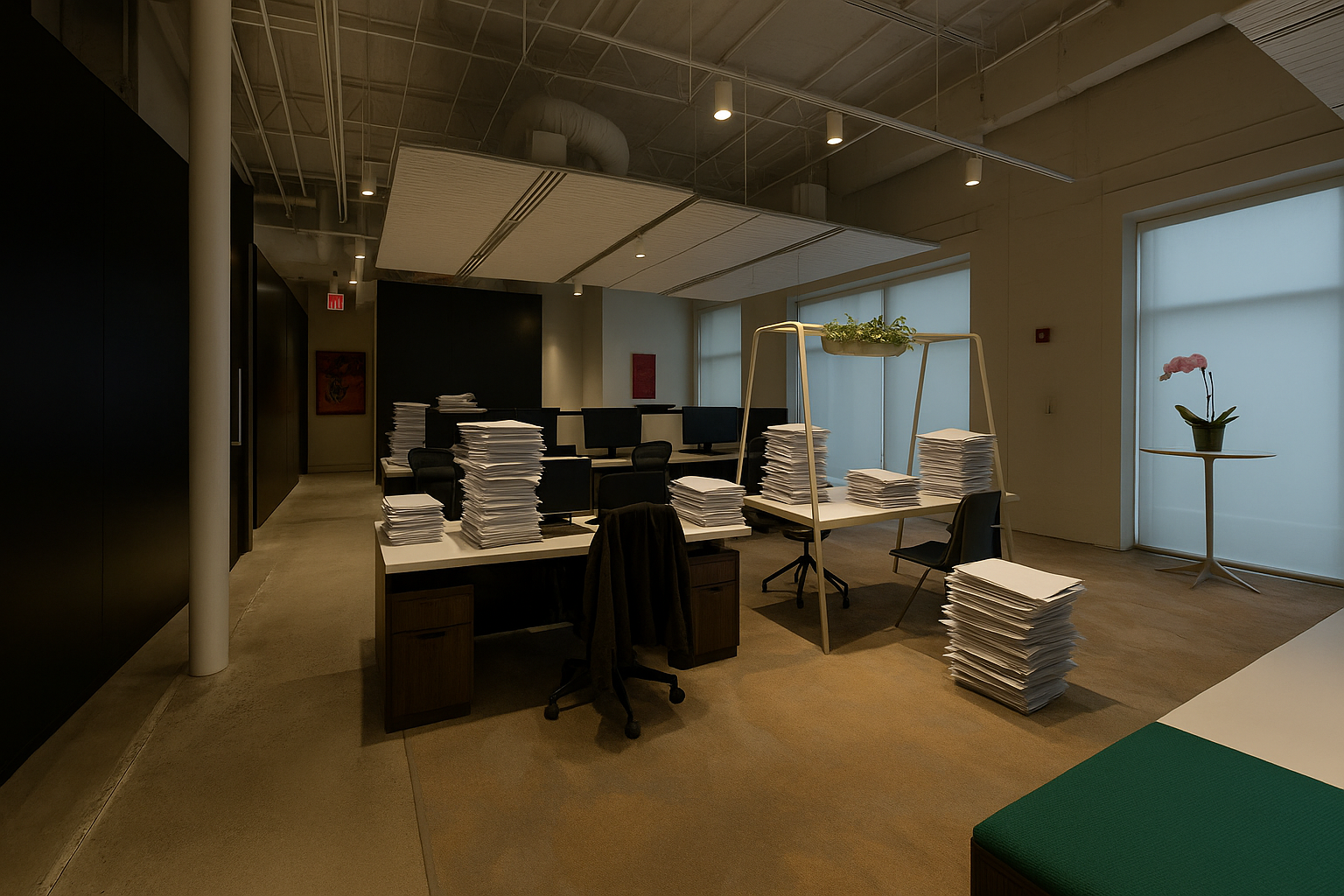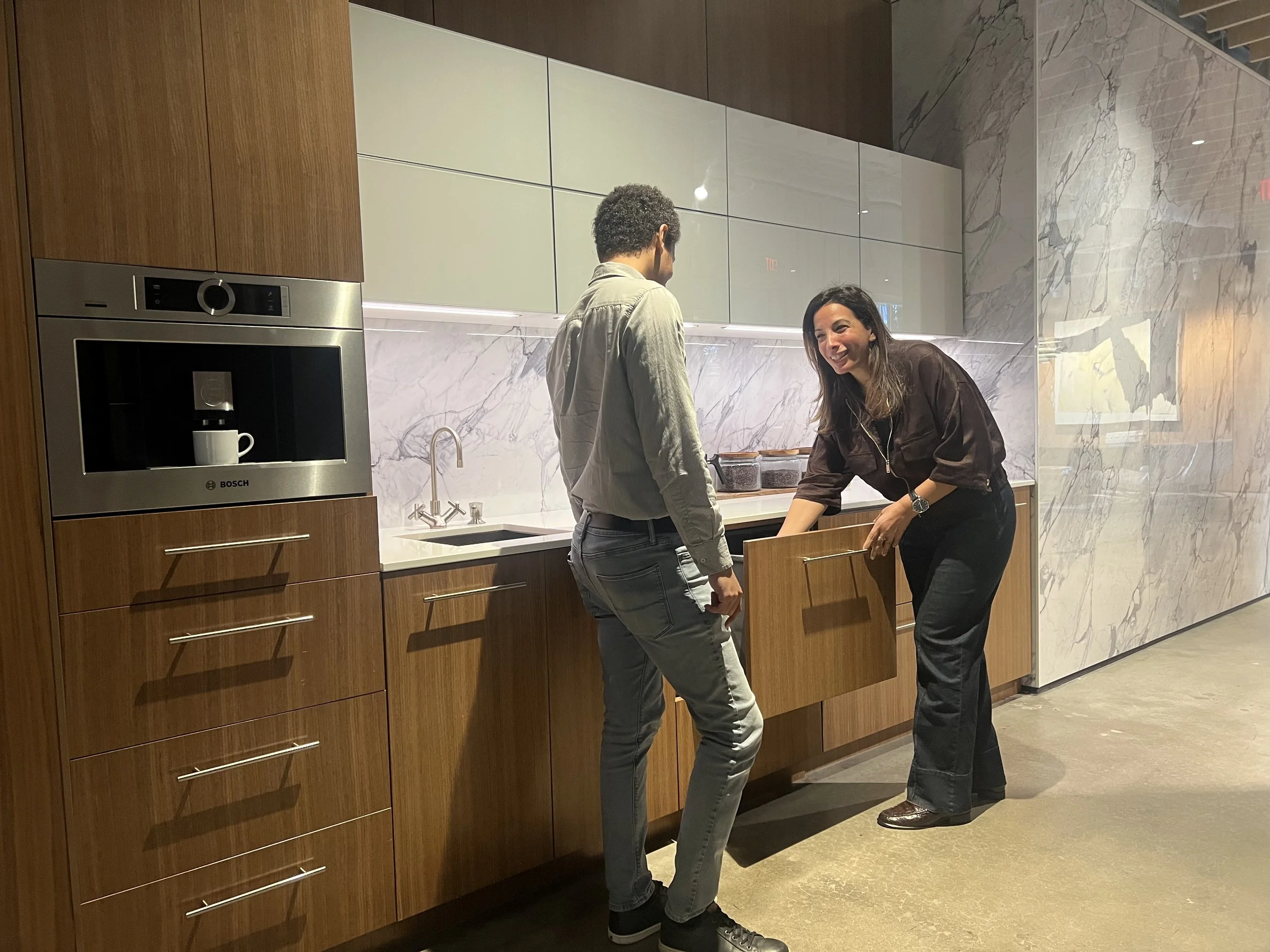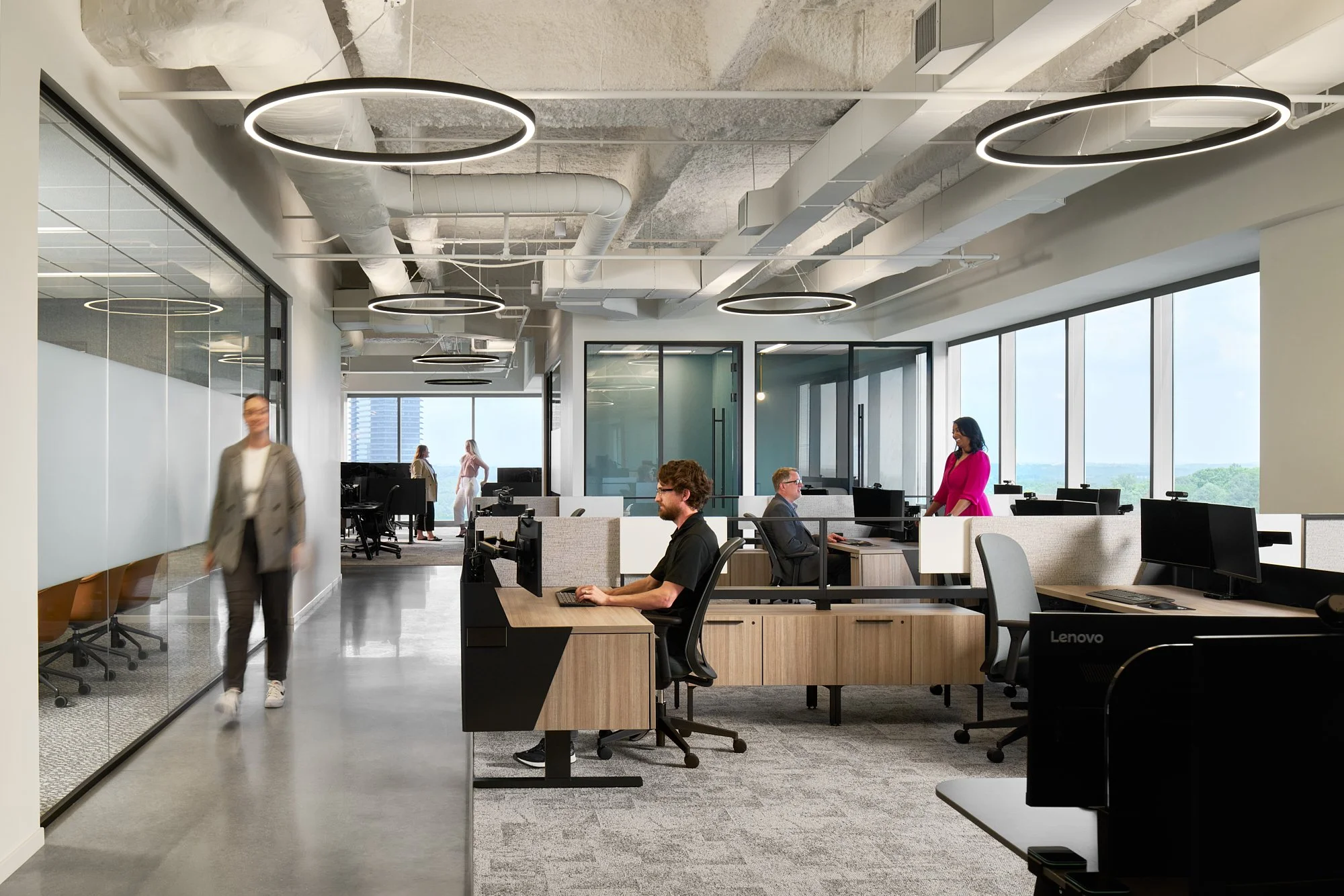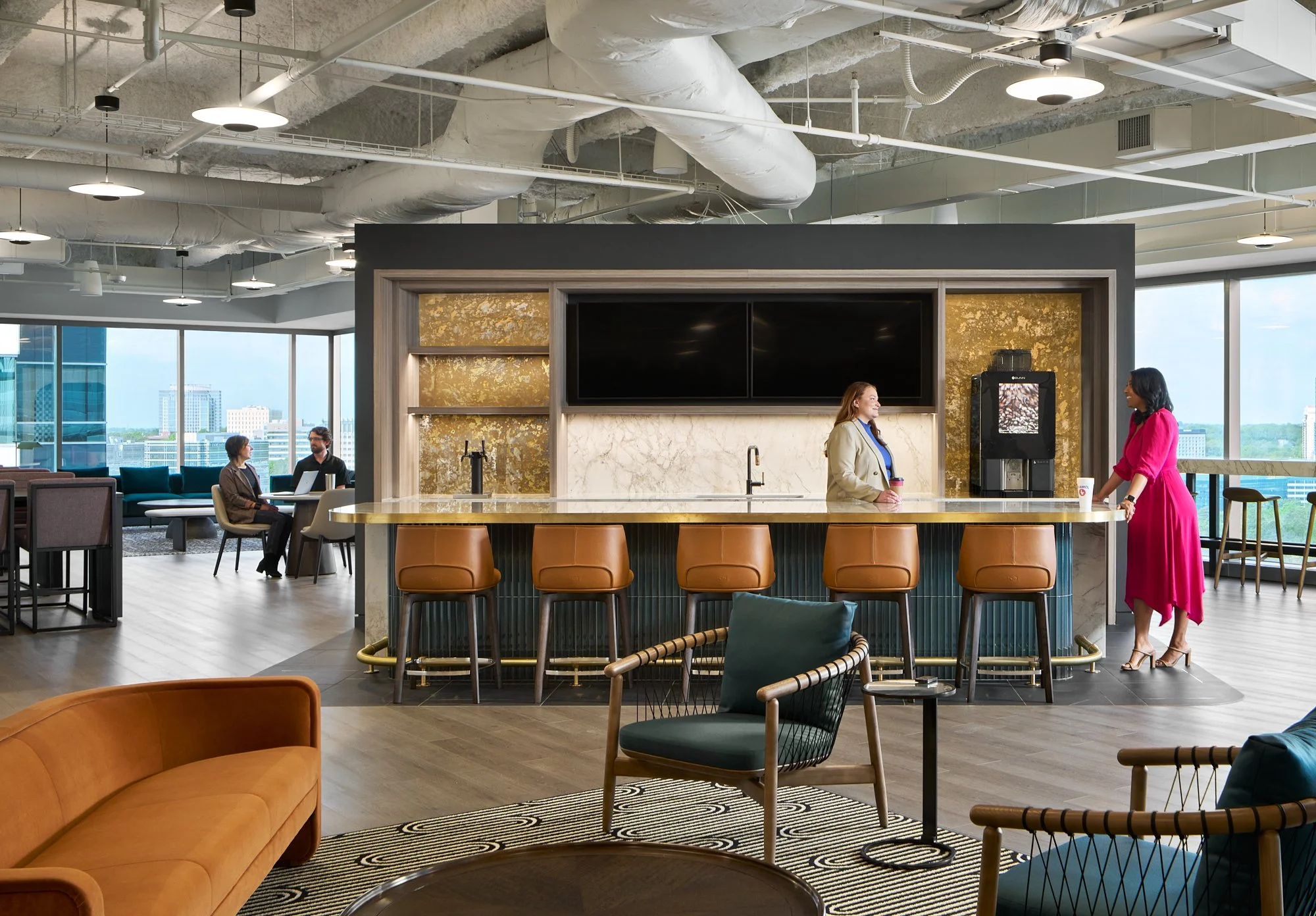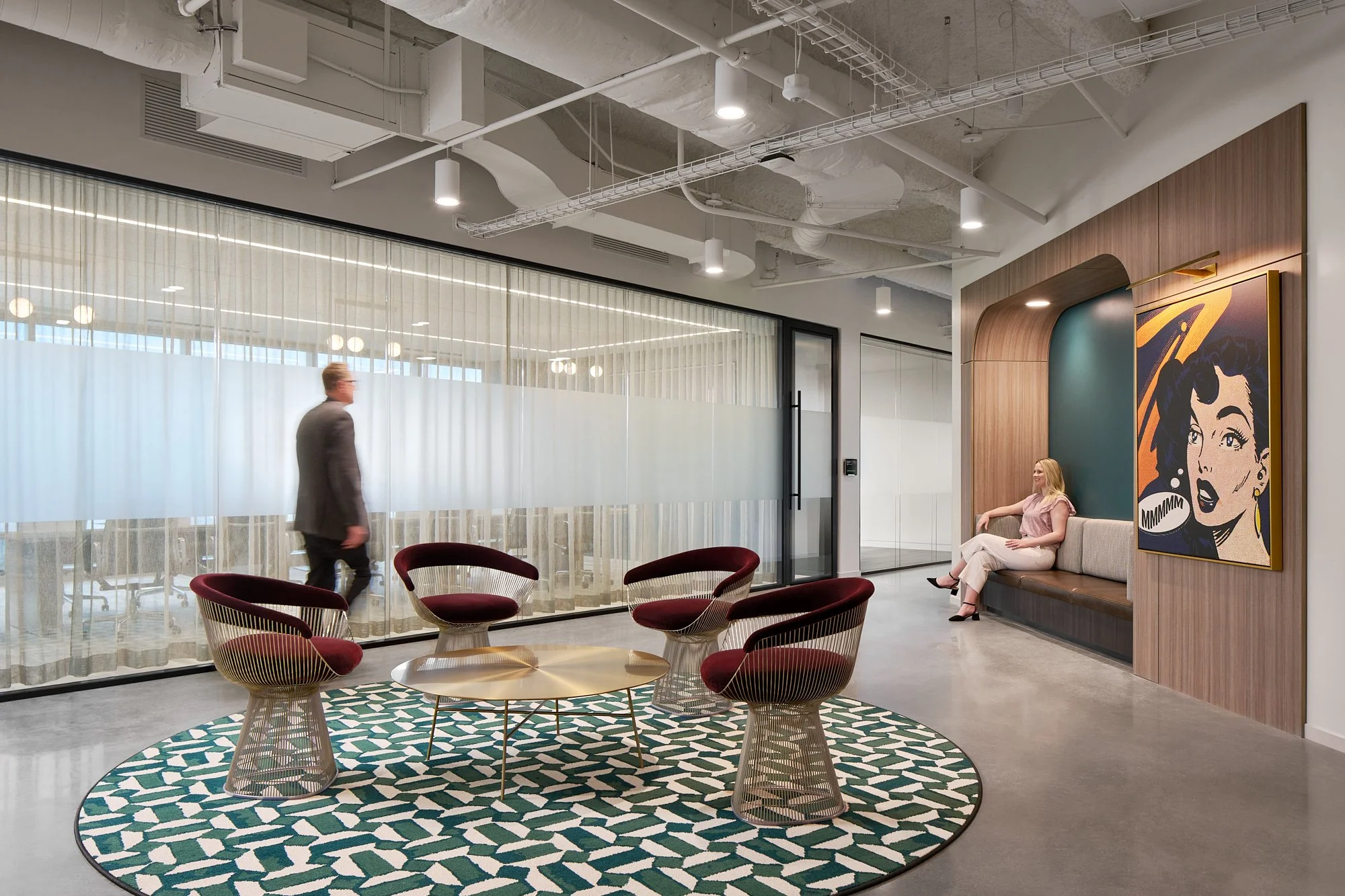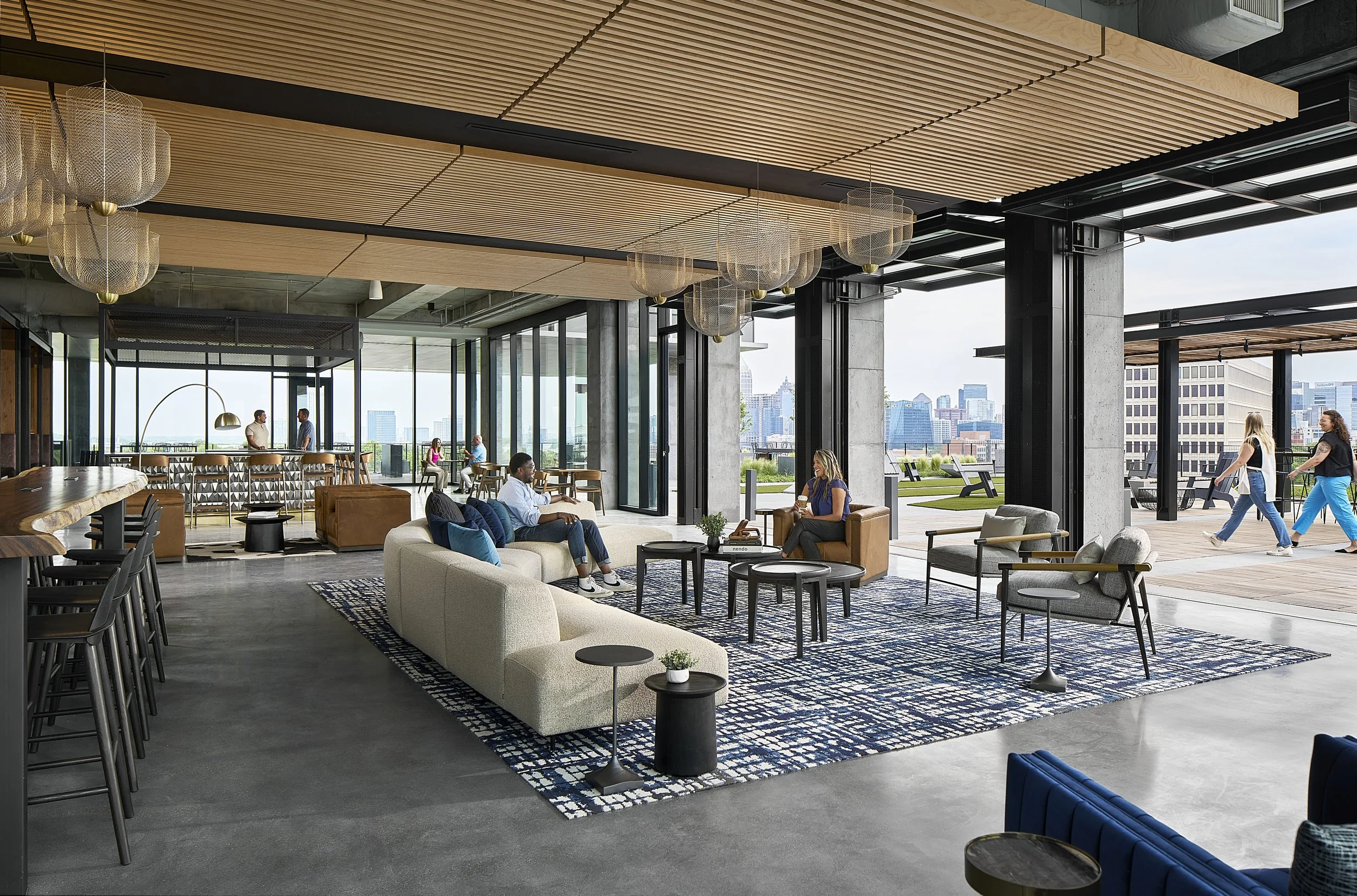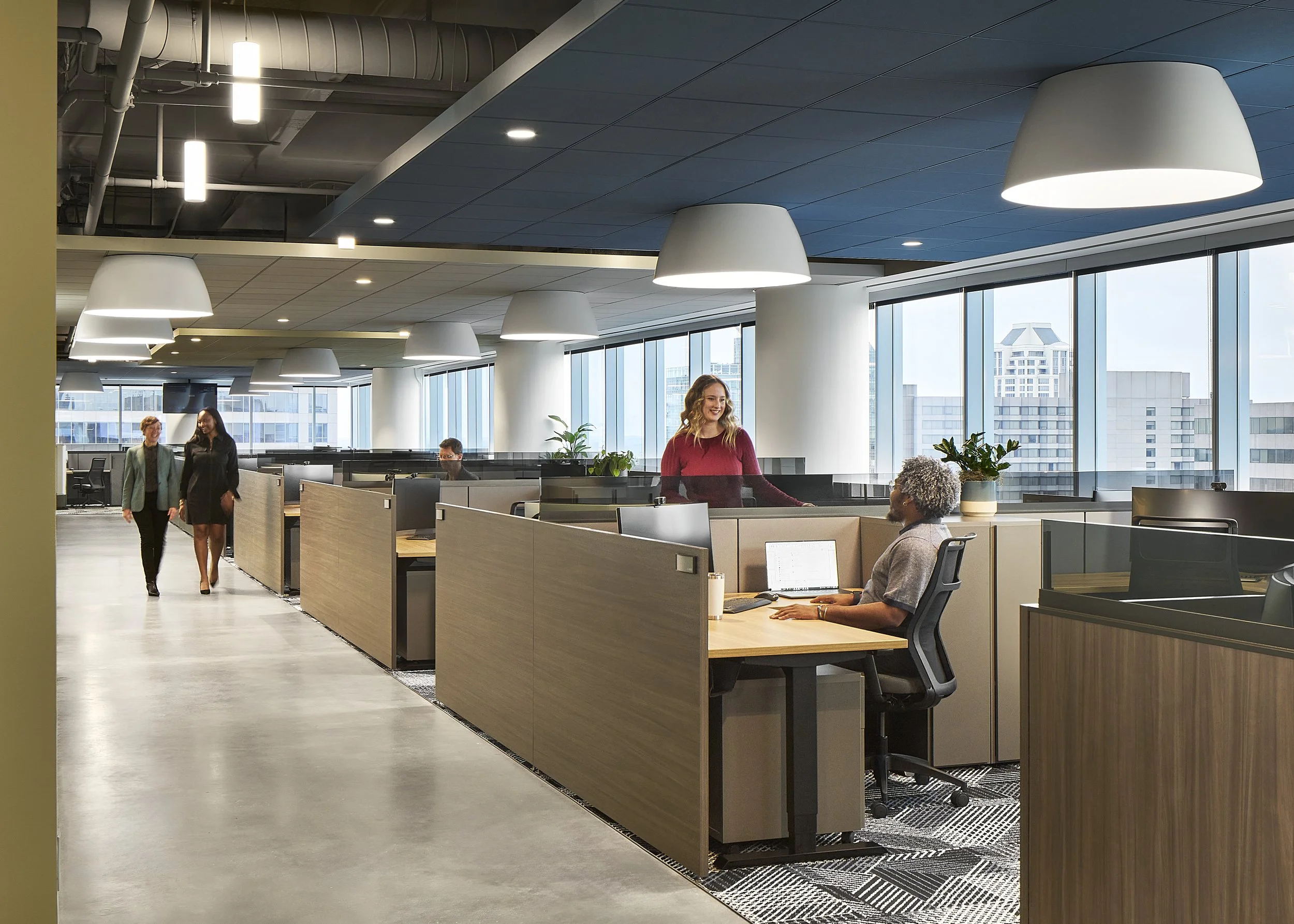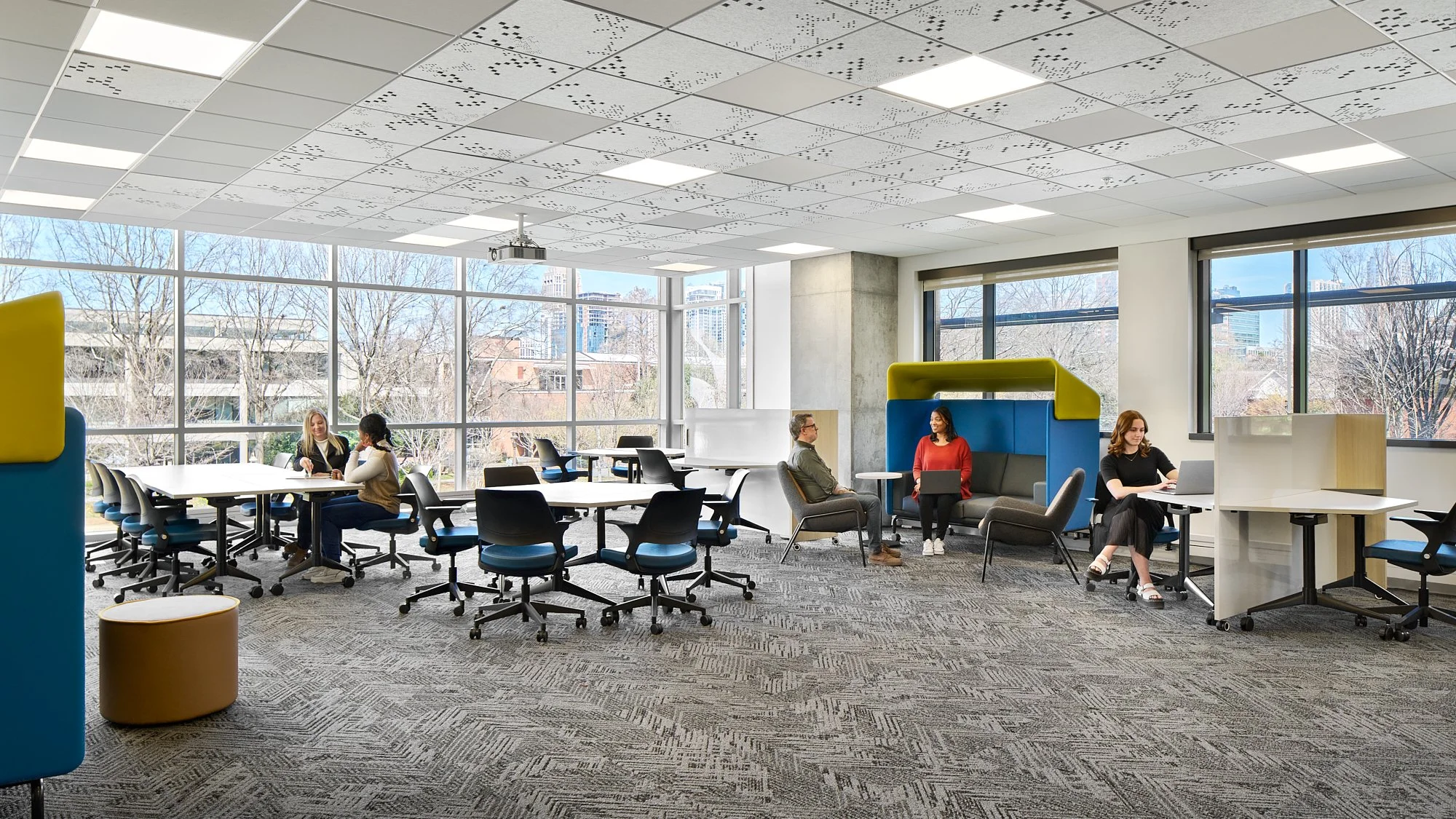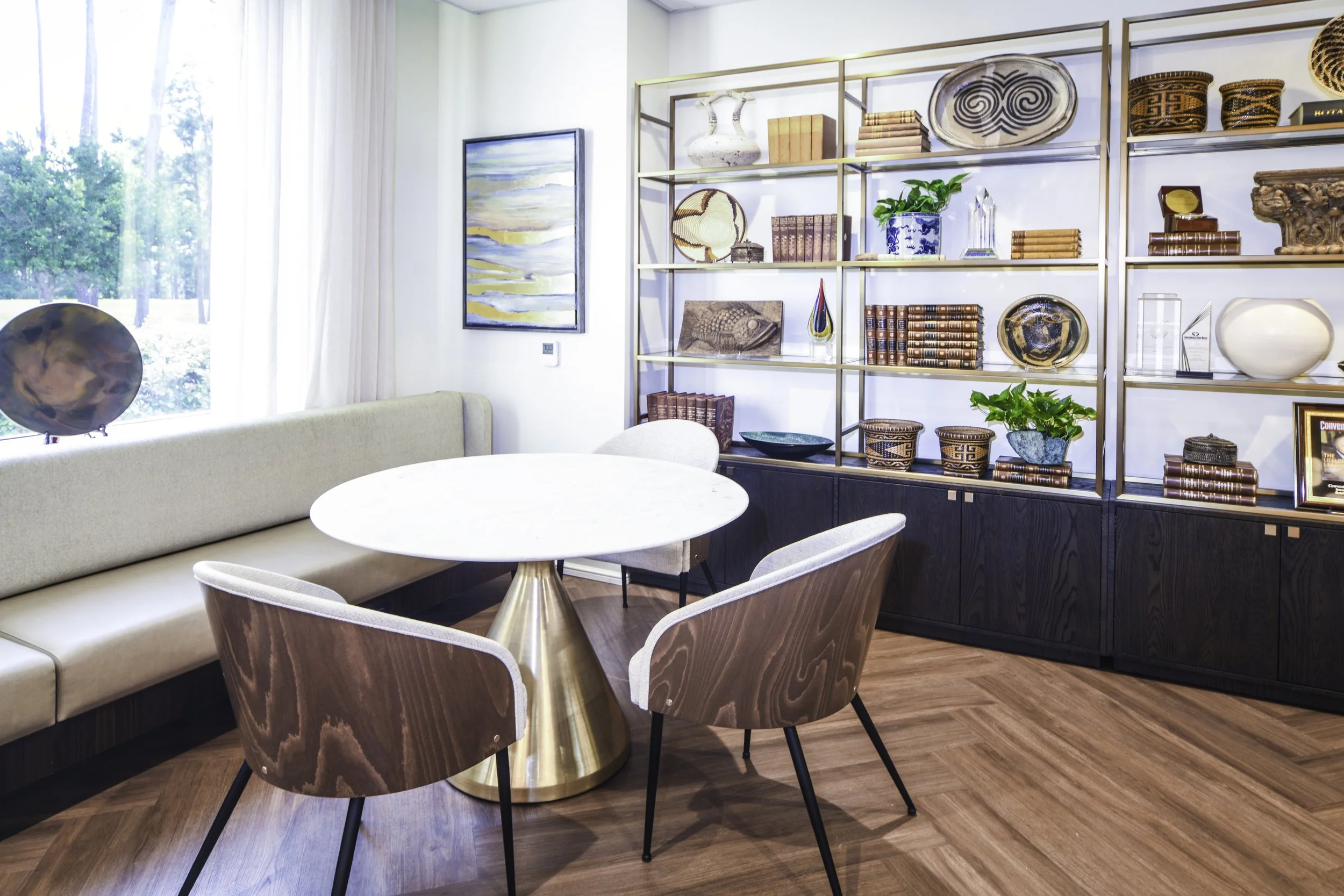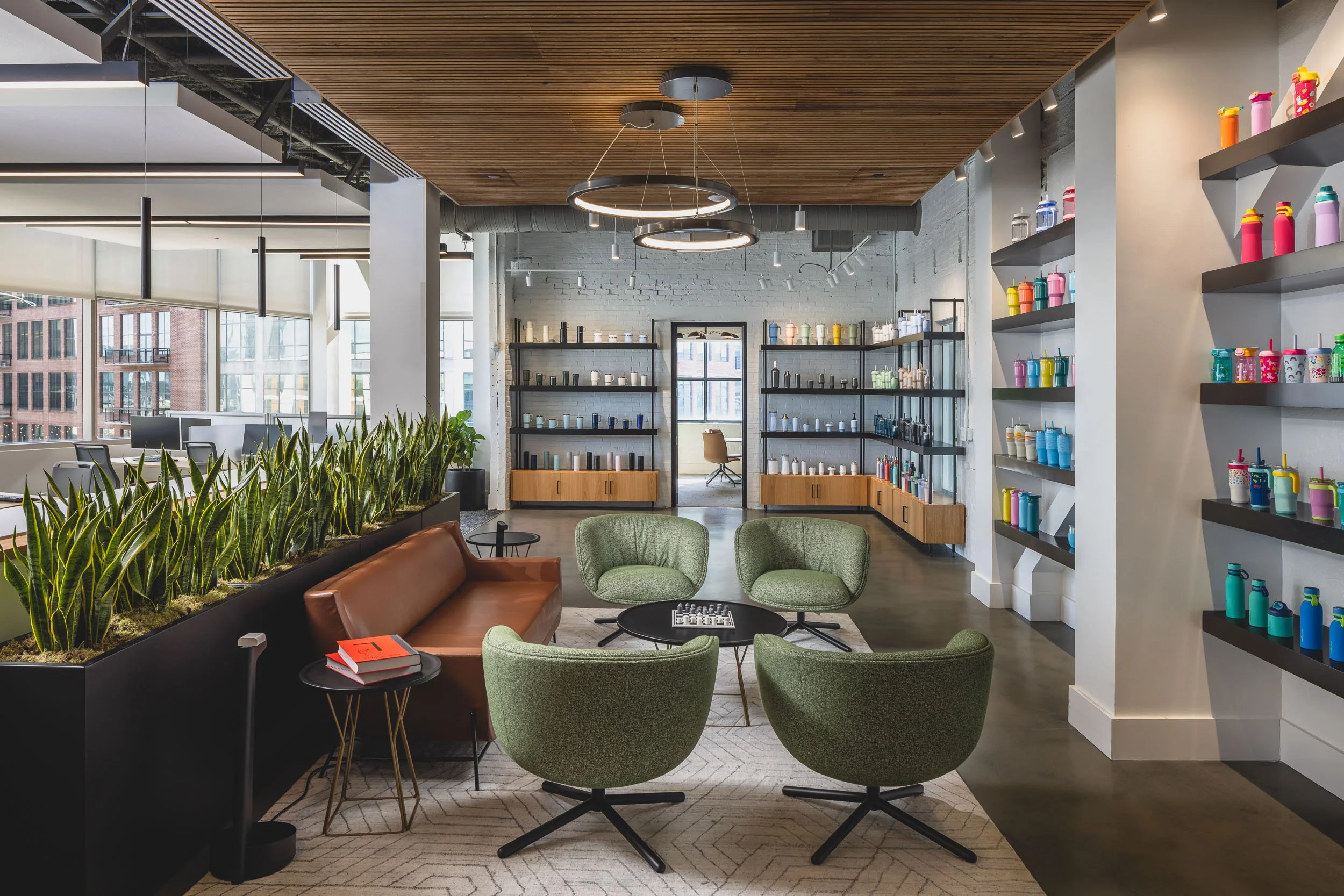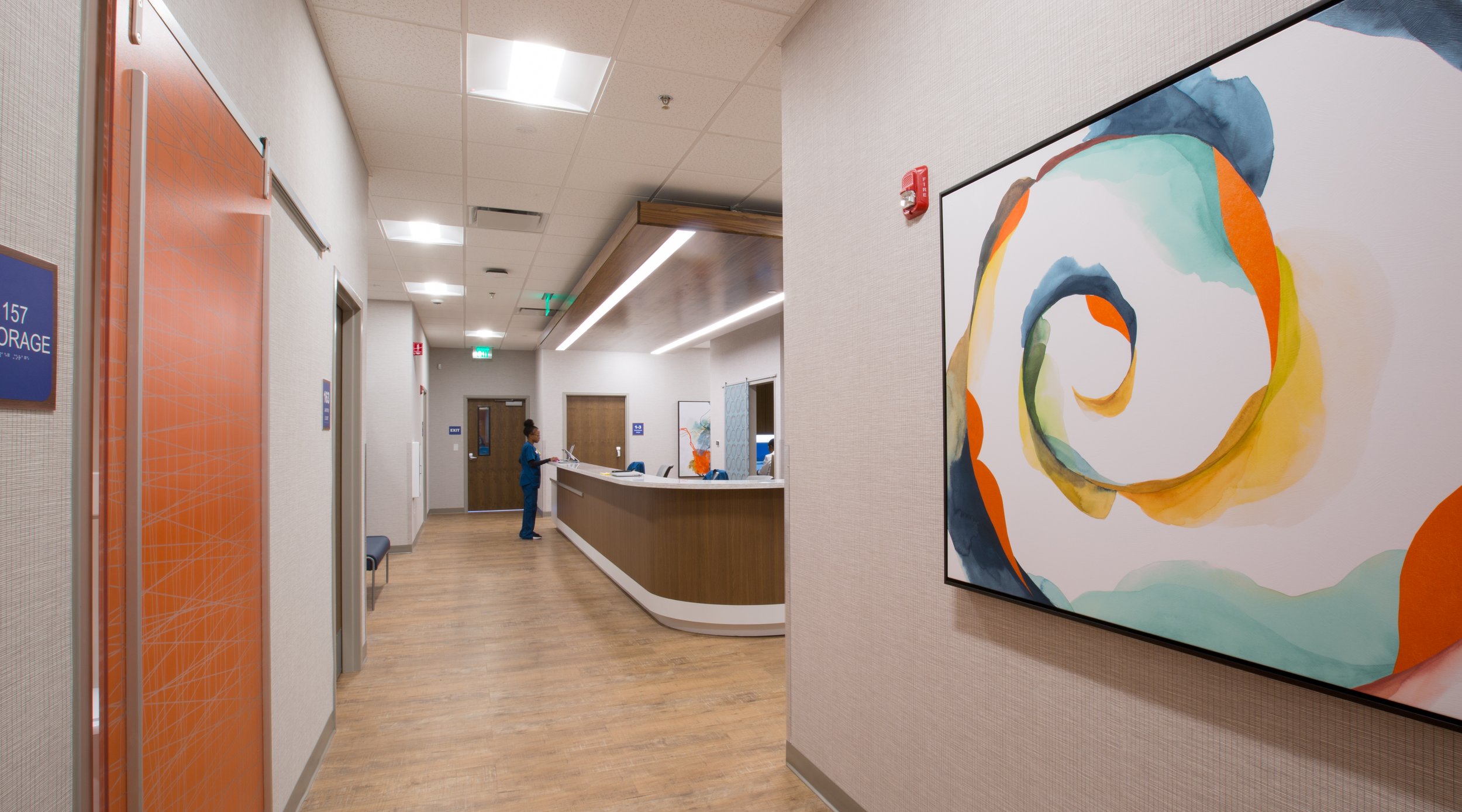Revisiting 2025 Workplace Trends Predictions: Were We Right?
Almost twelve months ago, at the start of 2025, we shared our take on the five emerging workplace trends: Adaptable Spaces, Nature’s Touch, Sustainability, Technology Integration, and Immersive Environments.
Almost twelve months ago, at the start of 2025, we shared our take on the 5 emerging workplace trends: Adaptable Spaces, Nature’s Touch, Sustainability, Technology Integration, and Immersive Environments.
A lot has happened since then—return-to-office momentum picked up, AI moved from new to a daily tool, energy costs spiked again, and employees made it clear they’ll vote with their feet if the office doesn’t feel worth the commute.
So, how did our predictions hold up? Let’s look at the data, the projects we’ve completed this year, and what clients are actually asking for as we close out 2025.
1. Adaptable Spaces → Correct
What we saw in January turned into a flood. Companies that dragged their feet on flexible layouts in 2024 suddenly had no choice in 2025: 55% of global occupiers now utilize flexible office solutions, with 17% planning to increase their use Global Flexible Office Trends 2025 | Cushman & Wakefield
—either you have adaptable spaces or you’re out.
2. Nature’s Touch (Biophilia) → Correct, but with a twist
Biophilic design exploded in North America and northern Europe, but adoption was slower in dense markets where outdoor air quality remains a challenge. DIRTT’s Breathe living walls is a cost effective, low-maintenance way to bring the outside in.
The new development in 2025: clients are pairing living walls with air-quality sensors and tying the data to their ESG reports. It’s no longer just “looks nice”—it’s measurable filtration + employee satisfaction + carbon reporting.
3. Sustainability → Correct
We said sustainability was a necessity. It turned out to be the necessity.
Manufacturers are committed to create a better world. This year, DatesWeiser transitioned to MillerKnoll’s multisite FSC chain of custody certificate), reinforcing its commitment to sustainable wood sourcing. By working closely with suppliers, the Supply Management team successfully shifted inventory to FSC-certified materials without compromising quality. As a result, FSC-certified wood purchases at DatesWeiser surged from under 5 percent to 67 percent in just one year! 2025 Better World Report
4. Technology Integration → Correct, AI has changed everything
Occupancy sensors that simply turned lights on and off? Old news.
In 2025, the standard is now technology integration, adaptive controls that learn behavior patterns, and smart lighting ecosystems that respond to people—not the other way around.
A perfect example of this was a recent collaboration with LUMIEN Lighting. The client wanted a space that would truly “wow” guests, showcasing their lighting in key. By integrating DIRTT, AV/data solutions, Mechoshades, and carefully curated furniture, we created a cohesive environment that highlighted LUMIEN’s innovative lighting. The high ceilings and expansive open spaces presented a challenge, but strategic furniture placement, focal walls, and thoughtful circulation ensured the space felt grand without being overwhelmed.
Working closely with LUMIEN, we used renderings, material samples, and showroom visits to help them visualize the possibilities and make confident decisions. The result? A fully integrated, technology-forward environment that not only enhanced the aesthetic of their lighting but also demonstrated how technology integration can create an immersive and adaptive experience for all.
5. Immersive Environments → Correct, the number 1 reason people show up.
We thought sensory design would be important. We didn’t expect it to become the single biggest reason employees cite for wanting to come to the office.
58% of employers surveyed cited cultivating culture and belonging as leading motivators for returning to the office, while 46% emphasized meaningful interpersonal connection. https://www.jll.com/en-us/insights/2025-outlook-on-global-design-trends
Ready to stop guessing and start building the 2026-ready workplace that actually gets people excited to show up?
Let’s talk. The trends we predicted aren’t emerging anymore—they’re here.
Designing with Women in Mind: Supporting Comfort, Inclusion, and Productivity
As a certified MillerKnoll dealer, we embrace research-driven insights to help companies normalize conversations around menopause and create environments that enhance comfort, focus, and well-being. From temperature control and tunable lighting to supportive seating and wellness spaces, thoughtful design empowers individuals to thrive—because when we design for people, we design for possibilities.
In the U.S., menopause-related challenges contribute to an estimated $1.8 billion in lost productivity annually due to missed workdays. Symptoms like joint discomfort, fatigue, difficulty concentrating, hot flashes, sleep disruption, and anxiety can all affect workplace comfort and performance - for those experiencing menopause and their colleagues alike.
We are a proud certified MillerKnoll dealer. Together, we are reimagining the future of work by designing environments that consider every human experience. MillerKnoll’s insights strategists, design experts, and Women’s Business Resource Group collaborated with menopause consultant Kate Usher to better understand how culture, policy, and space design can improve the work experience for all employees. Their research reinforces that the first step is normalizing the conversation around menopause in the workplace.
How Design and Culture Work Hand in Hand
Building awareness that menopause is a natural and universal experience encourages open, respectful dialogue. Companies can empower groups to lead conversations and advocate for supportive workplace resources.
Training managers means giving them the tools to recognize when support might be needed and helping connect employees with appropriate resources or accommodations.
Establishing clear communication strategies allows organizations to define how menopause is discussed in a way that aligns with company culture and values.
Design Solutions That Support Comfort and Well-Being
We take these principles and translate them into practical design solutions that enhance comfort, focus, and confidence:
Temperature Control
Tunable LED lighting
Wellness Rooms
Sit-to-stand desks and supportive seating
When we normalize conversations about menopause and design with empathy, we create workplaces that retain talent, promote wellness, and empower individuals to perform at their best, no matter their life stage. We’re proud to be part of this important movement.
Because when we design for people, we design for possibilities.
Spooky Office Design Mistakes: 5 Fails That Haunt Your Workspace
Spooky Office Design Mistakes: 5 Fails That Haunt Your Workspace
Even the best office designs can hide sneaky problems. These common mistakes linger like ghosts, quietly draining productivity, comfort, and team spirit. Here are five ghastly design fails and how to banish them for good.
The Zombie Floor Plan (Inefficient Space Utilization)
The Problem: Tiny desks, clunky layouts, empty areas, and confusing walkways. Spaces that can’t adjust when needs change.
Why It’s Spooky: It causes confusion, blocks teamwork, and makes simple movement feel like an obstacle course. Rigid layouts also make it tough to adapt — lowering morale and productivity as organizational needs shift.
How to Fix It: Use furniture that can be moved or be rearranged as teams grow or shift. Plan clear paths for walking, avoid “dead corners” that never get used, and take advantage of wall and side spaces for storage so main areas stay open and useful.
The Vampire Light Trap (Bad Lighting Design)
The Problem: Too little natural light, windows that are blocked off, or offices that rely too much on harsh artificial lighting.
Why It’s Spooky: Natural light boosts mood, energy, and focus. Without it, people can feel drained or get headaches. Overly bright, harsh lights can be just as bad.
How to Fix It: Position workspaces near windows, use glass walls or light panels so daylight can spread further throughout your space, add flexible lighting options, like dimmers or layered lights for different tasks, choose warmer tones that feel like daylight and avoid flickering or glaring lights.
The Whispering Wraith (Lack of Privacy & Acoustic Discomfort) The Problem: Open-plan offices without quiet zones, sound masking, or places for private conversation; noisy common areas bleeding into work zones. Why It’s Spooky: Noise and lack of privacy hurt concentration, make sensitive discussions difficult, and make people feel exposed or overstimulated How to Fix It: Incorporate acoustic treatments: panels, sound-masking systems, carpets, ceiling baffles, create designated quiet/focus zones and private meeting pods or booths, and use furniture (high-back chairs, screens) to create visual/aural separation without shutting off light.
The Collaboration Void (Not Enough Team Spaces)
The Problem: Too few casual spots for brainstorming, relaxing, or quick chats. Meeting rooms are either too formal or always booked.
Why It’s Spooky: Without space to connect, share ideas, or collaborate, creativity slows down, teams feel isolated, and innovation fades away.
How to Fix It: Add casual hangout areas with comfy seating and writable walls. Mix it up with different options: formal conference rooms, relaxed lounges, bookable pods, and flexible shared spaces, so teams always have somewhere to gather.
The Clutter Crypt (Messy & Disorganized Spaces)
The Problem: Not enough storage. Mess piles like scattered papers, tangled cords, and personal items with no place to go.
Why It’s Spooky: Clutter distracts people, wastes time, raises stress, and makes it harder to stay focused and tidy.
How to Fix It: Add smart storage like built-in cabinets, under-desk drawers, or wall units. Plan for cable management in furniture or with accessories. Encourage clean-desk habits when it makes sense, and make sure everyone has enough storage for their needs.
Final Thoughts
Don’t let your office become a haunted mansion of poor design. Fixing these five common mistakes can dramatically improve how people feel, interact, and perform at work. A few thoughtful changes can turn that “spooky” atmosphere into one of energy, focus, and creativity.
Ready to cast out your office design terrors? We can help audit your space and plan improvements that make everyone feel more comfortable, productive, and happy. Contact us to start your transformation.
DIRTT Construction: Common Questions
When it comes to new or different construction methods, it’s natural for clients and partners to have questions. At Corporate Environments, we know that DIRTT can feel unfamiliar at first. To make things easier, we’ve rounded up some of the most common concerns we hear, and how DIRTT answers them.
Muna demonstrating DIRTT’s Casework
When it comes to new or different construction methods, it’s natural for clients and partners to have questions. At Corporate Environments, we know that DIRTT can feel unfamiliar at first. To make things easier, we’ve rounded up some of the most common concerns we hear, and how DIRTT answers them.
“DIRTT seems too expensive.”
Upfront costs can sometimes feel higher, but the value of DIRTT is in the long-term benefits. With offsite construction, you’ll see savings in project schedules, reduced labor from other trades, and fewer delays. By involving the DIRTT team and your general contractor early, we can identify where you’ll save both time and money across the entire project.
“I don’t think I need flexibility in my space.”
Flexibility often isn’t top of mind until it’s needed and by then, traditional construction makes even small changes a hassle. Adding an outlet, adapting for new tech, or updating finishes can become costly and disruptive. DIRTT’s modular approach makes those updates seamless, giving you future-ready spaces that can adapt as your needs change.
“The timeline for DIRTT is a challenge.”
DIRTT often moves faster than conventional methods. Most items are ready in less than two weeks. Even custom details, like anodized frames and doors, are produced in about 14 days, while solid painted tiles take around 21 days plus shipping. This speed keeps projects on track and helps you get to the finish line quicker.
“I’m concerned about the aesthetics and quality of ‘modular’ construction.”
Modular doesn’t mean cookie-cutter. DIRTT is designed with aesthetics in mind, from spanning finish tiles across elevations for a seamless look to high-quality finishes that match your design vision. The removable “skin” adds function without sacrificing form, creating a polished space that looks as good as it works.
“Is DIRTT compliant with building codes and inspections?”
Absolutely. All DIRTT solutions are UL rated and NFPA tested, ensuring compliance with safety and building standards. You can move forward with confidence knowing your project not only looks great but also meets every requirement.
“DIRTT sounds complicated to specify for a project.”
The DIRTT Constructability team makes it simple. They work directly with architects to create drawing sets and provide CSI specification sections for all applications. Their goal is to make DIRTT the Basis of Design, streamlining the process so everyone involved benefits from clarity and efficiency.
Diversity in Design: Why Representation Matters in Commercial Spaces
Furniture does more than fill a space; it influences how we work, connect, and feel. For architects and designers, partnering with a trusted furniture dealership early in the planning process can be the key to creating environments that are functional, adaptable, and built for long-term success.
Image credit: Garey Gomez
Design has the power to shape how we feel, interact, and engage with the world around us. But who is behind the design? Whose stories, perspectives, and identities influence the spaces we work in, collaborate in, and build culture in?
At Corporate Environments, we believe that design should be as inclusive and representative as the communities it serves. That’s why diversity in design, both in the process and the people, isn’t just important; it’s essential.
Representation Drives Better Design
Studies and real-world outcomes continue to reinforce a simple truth: teams that include a variety of backgrounds, perspectives, and lived experiences produce more innovative and human-centered designs.
From the early stages of concepting a workplace to the finishing details of a hospitality space, diversity in design ensures that environments are not only functional and beautiful, but equitable and welcoming. As highlighted by experts at Big Human, it’s not just about who’s in the room, it’s about the richness of perspective that shapes the decisions being made.
Image credit: Garey Gomez
The Architectural Digest feature spotlighting 21 Black women transforming architecture and design further proves this point: representation isn’t symbolic, it’s foundational to progress. These designers bring cultural context and new narratives into the environments we inhabit daily, shifting the industry’s visual language toward something more inclusive.
Commercial Spaces Reflect Company Values
Today’s leading organizations recognize that their physical spaces are an extension of their brand and values. A thoughtfully designed commercial environment can foster a sense of belonging, inspire creativity, and encourage collaboration, but only if the design process itself is inclusive.
This is especially important in spaces that serve a diverse population, whether it's a workplace, university, healthcare facility, or civic building. Inclusive design isn’t about checking a box; it’s about designing with them instead of just for them.
Our Commitment: Diversity in Design and Supply
As a certified Minority Business Enterprise (MBE), Corporate Environments is proud to be part of a larger movement that promotes diversity not only in design output but also in the design economy.
Image credit: Garey Gomez
Supplier diversity is a key part of this equation. According to McKinsey, organizations that engage certified diverse suppliers not only contribute to a more equitable business landscape, but also gain greater innovation, responsiveness, and resilience.
Through our MBE status and deep industry partnerships, we are uniquely positioned to bring both design excellence and diverse perspectives to every project. It’s a win for our clients, our collaborators, and our community.
Designing the Future Together
We envision a future where commercial design truly reflects the richness of the world around us; where spaces are co-created with diverse voices and inclusive intentions.
By engaging diverse talent across our entire company, championing supplier inclusion, and staying rooted in our commitment to representation, we hope to continue shaping spaces that not only look good but do good.
How Early Furniture Dealership Involvement Enhances Workplace Strategy
Furniture does more than fill a space; it influences how we work, connect, and feel. For architects and designers, partnering with a trusted furniture dealership early in the planning process can be the key to creating environments that are functional, adaptable, and built for long-term success.
Furniture does more than fill a space; it influences how we work, connect, and feel. For architects and designers, partnering with a trusted furniture dealership early in the planning process can be the key to creating environments that are functional, adaptable, and built for long-term success.
Strategic Partnership from Day One
A great furniture dealership brings more than just products to the table. From the initial planning phase, they offer valuable insight into space design, ergonomics, workflow, and brand alignment. They help guide decisions around layouts, styles, and materials that not only enhance visual appeal but also support how your team operates now and considers your needs for the future. Acting as a single point of contact, the dealer manages everything from procurement to installation, reducing delays and minimizing stress. The result? A more seamless process, fewer disruptions for your team, and a workspace that functions as beautifully as it looks.
Access to Custom and Certified Solutions
Working with a certified dealer unlocks access to top-tier manufacturers and custom product options not available to the general market. Through established partnerships with trusted brands, dealers can source high-quality, tailored pieces that meet your specific design, function, and performance needs. Whether you're looking for a unique finish, a particular size, or a precise ergonomic fit, dealers can deliver options that align with your vision, budget, and timeline, bringing the full power of manufacturer resources to your project.
Enhancing the Design Process
Design success depends on strong collaboration, and furniture dealers are a crucial part of that team. By working closely with architects and designers, they ensure that furniture choices align with the aesthetic, technical, and functional goals of the project. Their expertise in materials, compliance standards, and workplace trends helps balance creativity with practical considerations like budget, lead times, and long-term durability. This ensures every piece not only fits the vision but performs in the real world, without compromising the overall design intent.
Driving Broader Industry Impact
Beyond individual projects, dealers shape broader market trends and influence product availability, pricing, and design. Their involvement in trade shows and manufacturer networks keeps them informed and positioned to deliver forward-thinking solutions. Dealers stay connected to the evolving furniture landscape so they can keep your projects aligned with the latest innovations, supply chain strategies, and market opportunities.
The Takeaway
A great furniture dealer is not just a supplier, but a strategic partner in your project’s success. Early collaboration leads to stronger outcomes, fewer disruptions, and spaces that deliver lasting value.
With decades of experience and long-standing relationships with manufacturers like MillerKnoll, Corporate Environments brings insight, organization, and creativity to every project. We work with architects, designers, and business leaders to create workspaces that perform both in function and feel. Ready to plan smarter? Let’s talk.
The Psychology of Design: How Furniture Shapes How We Work and Feel
This morning, I stepped into a conference room for what should’ve been a simple meeting, but something felt off. The lights were too bright, the chairs were stiff, and the plain walls did little to inspire. Instead of feeling ready to collaborate, I found myself distracted, disengaged, and eager to leave.
This morning, I stepped into a conference room for what should’ve been a simple meeting, but something felt off. The lights were too bright, the chairs were stiff, and the plain walls did little to inspire. Instead of feeling ready to collaborate, I found myself distracted, disengaged, and eager to leave.
It wasn’t the meeting agenda throwing me off, it was the space itself. It made me wonder: how often do we underestimate the role our environment plays in how we think, feel, and perform?
In today’s evolving work culture, productivity isn’t just about meeting deadlines or using the latest tools. It’s also deeply influenced by design. From furniture choice to room layout, every element in a workspace sends signals that impact our mood, mindset, and performance. Let’s dive into each piece that completes the picture of a thoughtfully designed and executed workspace.
Why Furniture Design Matters
Furniture does more than fill a room, it shapes the experience within it. The shape of a chair, the color of a desk, the texture of a couch- these elements set the emotional tone of a space. They influence how people collaborate, focus, relax, and create.
Shapes and Forms Influence Behavior
Humans naturally respond to certain shapes. Rounded, organic forms feel warm and approachable, making them ideal for collaborative areas where connection matters. Think: circular tables, curved chairs, soft edges.
On the flip side, angular, geometric lines convey structure and discipline- perfect for focus-driven spaces like private offices or heads-down zones. The form of the furniture quietly directs behavior and when executed properly, we’re often unaware of its influence.
Texture and Material Affect Mood
Furniture isn't just about aesthetics. It's a tactile experience. A plush chair in velvet or wool creates a feeling of comfort and calm. In contrast, cold plastic or metal surfaces may feel harsh or impersonal.
Natural materials like wood, leather, and woven fabrics help ground us, subtly linking us to nature and reducing stress. When thoughtfully combined, textures can make a space feel both professional and personal, a place people want to be.
The Psychology of Color
Color goes beyond decorating, it directs energy. Cool tones like blue and green promote focus and calm, making them ideal for quiet zones or solo workspaces. Warm earth tones like terracotta and camel add warmth and welcome, while bold accent colors like mustard or teal bring energy and spark creativity.
Smart use of color helps define a room’s purpose and shape our emotional response to it.
Comfort, Ergonomics, and Well-Being
People do their best work when they’re comfortable. Ergonomic chairs, adjustable desks, and supportive seating can reduce strain and keep energy levels high. Even small improvements, like better back support or a height-adjustable desk, can make a big difference over the course of a long day.
When comfort is prioritized, productivity follows.
Layout, Flow, and Flexibility
Good design is about how everything fits together. A well-thought-out layout includes quiet areas for focus, open zones for teamwork, and flexible spaces that can evolve with changing needs.
Modular furniture, movable pieces, and clearly defined zones allow a space to function and adapt without sacrificing cohesion. In the age of hybrid work, that flexibility is more important than ever.
Final Thought: Design That Works as Hard as You Do
Design goes beyond aesthetics; it's about shaping spaces that enable people to perform at their highest potential. When we pay attention to shape, color, texture, and flow, we create spaces that support comfort, creativity, and collaboration.
As hybrid work becomes the norm, the demand for human-centered, adaptable design continues to grow. From sit-stand desks to biophilic design elements, the modern workplace is evolving to prioritize experience and well-being.
That’s why at CE, we partner with innovators like MillerKnoll, whose research-driven furniture solutions are built to enhance wellness, collaboration, and performance. Together, we help organizations create inspiring environments where people thrive.
Read more about MillerKnoll to explore how furniture design can support healthier, more productive work environments.
Need help designing a workspace that truly works? Contact us. We’d love to help you build a space that supports your team’s best work.
NeoCon & Design days 2025 Recap: Inspiration, Innovation, and What’s Next in Design
Design Days and NeoCon 2025 delivered bold ideas, forward-thinking materials, and a renewed sense of purpose across every showroom. This year’s events made one thing clear: the future of workplace design is not just about aesthetics but how they feel, how they adapt, and how they support both people and the planet.
Design Days and NeoCon 2025 delivered bold ideas, forward-thinking materials, and a renewed sense of purpose across every showroom. This year’s events made one thing clear: the future of workplace design is not just about aesthetics but how they feel, how they adapt, and how they support both people and the planet.
Sustainability, Wellness, & Material Innovation Lead the Way
Sustainability was not a trend; it was a baseline. Across the showrooms, designers showcased low-impact, transparent solutions in response to global environmental challenges. Climate-conscious material sourcing, sustainable circularity, and high-performance, long-lasting furnishings took center stage, balancing durability, beauty, and ecological responsibility.
Acoustic materials, felt, and ventilation-enhancing technologies were especially prominent. A standout was the Monolith Wall Scape from TURF, a bold, wood-textured acoustic solution that elevates design while minimizing echo. Many exhibitors also introduced carbon-neutral, bio-sourced, and recyclable vinyls, Pallas Textile’s Reve Collection and Mayer Fabrics’ Impact Collection were two standout examples of how sustainable material options are becoming more mainstream.
Designing for Neurodiversity and Sensory Well-Being
One of the most significant shifts this year was the focus on multisensory, neurodivergent-friendly environments. Spaces are increasingly designed to reduce stress, promote healing, and foster human connection. At Design Days, Mohawk Flooring’s carpeted sensory room was a powerful example of how thoughtful design can create calm, inclusive spaces.
Exhibitors embraced materials and layouts that balance tactile, acoustic, and cognitive comfort. Flexible spatial configurations, soft curves, warm wood finishes, and an abundance of natural light are shaping emotionally intelligent interiors that prioritize sensory well-being.
Bold Colors and Organic Forms Create Emotional Depth
Andreu Worlds’ Nina Lounge Chair
This year’s color palettes broke away from the expected neutrals, embracing deep, rich hues like purples, maroons, and forest greens. These saturated tones added depth and drama while remaining inviting when paired with earthy undertones.
Organic shapes and soft, flowing curves were a recurring theme across showrooms, emphasizing comfort, fluidity, and connection to nature. Notable pieces included Andreu Worlds’ Nina Lounge chair, designed with gentle curves for a supportive, welcoming feel, and Scandinavian Spaces’ Big Talk Collection, a modular seating system with striking color, curvature and a flexible, modern design. These designs seamlessly blended emotional depth with functional versatility, highlighting how color and form can work together to elevate human-centered spaces.
Spotlight on MillerKnoll
A highlight of the show was the powerful presence of our trusted partner in modern, design-driven furniture solutions, MillerKnoll. Their presentation paid tribute to the shared legacy of Knoll and Herman Miller, now united under the MillerKnoll name. Their archival-inspired display celebrated decades of design leadership and set the tone for what’s next. They showcased the upcoming launch of the Dividends Skyline from Knoll- a versatile designed system that supports dynamic open-plan spaces by balancing individual focus, team collaboration, and overall spatial harmony.
Adaptable, reconfigurable furnishings were a key focus across their brand collective showrooms, reflecting the demand for spaces that can evolve. Sit-to-stand collaboration tables and modular systems provided flexibility without sacrificing style or performance. The Spout Sit-to-Stand table from Herman Miller exemplified this, merging ergonomic benefits with clean, modern design- perfect for today’s collaborative and health-conscious workplaces.
MillerKnoll marked a major milestone at this year’s event with the debut of their new healthcare showroom, celebrating 50 years of innovation in healthcare design. The space honored their legacy while looking ahead, showcasing solutions that prioritize flexibility, empathy, and well-being. From patient-centered furnishings to adaptable environments, the showroom reflected MillerKnoll’s continued leadership in shaping spaces that support both care providers and the communities they serve.
Looking Ahead
This year’s NeoCon and Design Days confirmed that good design is deeply human. It responds to the world we live in- environmentally, socially, and emotionally. Whether through acoustic comfort, inclusive layouts, sustainable materials, or heritage-informed craftsmanship, this year's exhibitors made it clear: the future of commercial design is holistic, adaptive, and intentional.
Ready to bring these trends into your next project? Let’s connect.
Designing with Sunshine: How Natural Light Boosts Employee Well-Being
When it comes to workplace design, one of the most powerful tools isn’t technology, it’s natural sunlight. It impacts employee well-being, productivity, and energy. At Corporate Environments, we prioritize environments that not only function efficiently but also contribute to healthier, happier workdays.
Corporate Environments Showroom
When it comes to workplace design, one of the most powerful tools isn’t technology, it’s natural sunlight. It impacts employee well-being, productivity, and energy. At Corporate Environments, we prioritize environments that not only function efficiently but also contribute to healthier, happier workdays. Bringing natural light and elements of nature indoors has proven benefits that extend far beyond aesthetics.
Sunlight is key in regulating the body’s circadian rhythms, improving sleep quality and daytime alertness. It also helps the body produce Vitamin D, serotonin, and melatonin, which are linked to mood regulation, stronger immune systems, and better overall health. I found myself feeling low energy during the rainy week we had last month. I was drowsy, unmotivated, and couldn’t bring myself to do much-not even finish the Netflix show I’d been binge-watching- if that tells you anything about how natural light can affect a person’s well-being.
Research backs this up:
According to the National Renewable Energy Laboratory, sunlight improves mood, mental clarity, and visual comfort while reducing the symptoms of seasonal affective disorder. These effects not only enhance the day-to-day experience for employees but also support better attendance, focus, and performance. Whether you're reconfiguring your current workspace or planning a new one, here are ways to make sunlight a major feature:
Design Layout
Use open-plan layouts to help light move throughout the space.
Place workstations near windows for direct daylight exposure.
Incorporate large windows, skylights, glass partitions, reflective surfaces, and light shelves to bring in and distribute light effectively.
Technology Integration
Install automated shading systems like MechoShades to allow daylight while minimizing glare and heat gain. These systems are available in manual, motorized, or fully automated formats and help maintain visual comfort and energy efficiency.
Integrate dynamic glass that automatically adjusts tint based on sunlight levels.
Use light sensors that adjust based on the time of day.
Maintenance and Comfort
Keep windows clean and clear to maximize light flow.
Design zones with different levels of daylight, such as brighter collaborative areas and softer-lit private offices.
Corporate Environments Showroom
In addition to light, incorporating materials like wood, stone, and greenery helps reduce stress and improve focus. Even simple additions like potted plants or nature-inspired artwork can have a positive effect. Integrating more daylight also supports energy efficiency. By designing with sunlight in mind, organizations can reduce reliance on artificial lighting, lower utility costs, and contribute to long-term sustainability goals. Sunlight is more than a design choice; it benefits people and performance. From strategic layouts to automated shade solutions, incorporating daylight creates healthier, more productive workplaces.
Let us help you create spaces that make the most of natural light, bringing clarity, energy, and balance into everyday work experience.
Let’s Talk About Sterile Spaces: Why Patient Rooms Need a Warmer Touch
When we design patient rooms with empathy and warmth in mind, we send a powerful message: We see you. We care about your experience. Your emotional comfort matters here. Healthcare will always have clinical parts, we can’t (and shouldn’t) eliminate that.
Today, I found myself in a space many of us visit at some point—my doctor’s office. I was there for a checkup and some shots. A seemingly routine visit, but what struck me wasn’t the procedure itself—it was the space.
From the moment I walked into the exam room, I was overwhelmed. Bright, fluorescent lights, bare white walls, clinical equipment on display… the room was clean, yes—but also cold. Sterile. Impersonal. And for someone who’s always been afraid of needles (yes, still am at 28 years old), that atmosphere made everything worse. I tensed up, panicked, and ultimately felt dizzy. It reminded me how much our environment can impact our emotional and physical well-being, especially in healthcare.
So why are we still designing patient spaces like we’re stuck in the 1990s?
The Case for Comfort in Clinical Design
Patient rooms - whether in hospitals, outpatient clinics, or wellness centers - should be more than functional. They should feel safe, calm, and human.
Research in healthcare design shows that environments that are warm, thoughtfully lit, and visually comforting can actually help reduce patient anxiety, improve outcomes, and create a more positive overall experience.
1. Lighting Matters
Harsh and bright overhead lighting can trigger tension and unease. Dimmer switches, warm-tone bulbs, or even natural light (when possible) can significantly soften the feel of a room. A space that mimics natural daylight feels more welcoming and less intimidating.
2. Color Psychology in Action
All-white walls may feel “clean” to designers, but they can feel cold and clinical to patients. Incorporating soothing tones like soft blues, muted greens, or warm neutrals can help calm the nervous system. Even a small splash of color—like an accent wall or piece of art—can shift the mood.
3. Soft Furnishings & Textures
A room shouldn’t feel like a lab. Adding fabric elements like curtains, upholstered chairs, or textured wall panels helps absorb sound and soften the space. Even a cozy throw pillow or a subtle pattern can feel surprisingly comforting.
4. Art & Personal Touches
Artwork, photography, or quotes on the wall—especially when culturally inclusive and emotionally uplifting—can help patients feel less like a number and more like a person. Nature-inspired prints and abstract pieces work wonders.
5. Furniture Placement & Flow
Cluttered equipment or impersonal layouts send the wrong message. A thoughtful layout that prioritizes conversation, comfort, and care can help patients feel more in control and less overwhelmed.
Why It Matters
When we design patient rooms with empathy and warmth in mind, we send a powerful message: We see you. We care about your experience. Your emotional comfort matters here. Healthcare will always have clinical parts, we can’t (and shouldn’t) eliminate that. But we can design rooms that support not only treatment but also trust, relaxation, and healing.
As someone who spent part of today panicking under the bright lights of a sterile room, I know how much better it would have felt to walk into a space that welcomed me with warmth. Because every patient deserves to feel safe, grounded, and cared for. Even when they’re afraid of shots.
We consider the influence and impact that space has on both employees and patients, so you can put your trust in us to deliver a meaningful space in any healthcare facility. Don’t forget to check out how we transformed Aylo’s Medical Office building- your project could be the next change maker in the industry.
Healthy Beginnings: Designing a Workplace That Supports Employee Wellness
A healthy workplace doesn’t happen by chance, it starts with intentional design. As we recognize World Health Day on April 7, it’s the perfect time to rethink how work environments impact an employee’s well-being. From ergonomic solutions to biophilic design and healthcare-inspired materials, here’s how organizations can create spaces that support employee wellness in 2025 and beyond.
A healthy workplace doesn’t happen by chance, it starts with intentional design. As we recognize World Health Day on April 7, it’s the perfect time to rethink how work environments impact an employee’s well-being. From ergonomic solutions to biophilic design and healthcare-inspired materials, here’s how organizations can create spaces that support employee wellness in 2025 and beyond.
Healthy Beginnings Start With… Ergonomic Workspaces
A comfortable and supportive workspace is the foundation of well-being. Employees spend long hours at their desks, so investing in ergonomic furniture is essential.
Consider:
Sit-to-stand desks to encourage movement throughout the day
Adjustable seating that promotes proper posture and reduces strain
Monitor arms & keyboard trays for an optimal work position
MillerKnoll’s ergonomic solutions—such as Nevi Sit-to-Stand Desk, Embody Chair, and Flo Monitor arm—ensure employees start their workday feeling comfortable, supported, and pain-free.
Healthy Beginnings Start With… Biophilic Design
Nature has a profound impact on reducing stress, improving focus, and enhancing mood- this is not news to us, since the pandemic many organizations have implemented some form of biophilia in their spaces. Bringing the outdoors into the workplace fosters a sense of well-being and balance.
Incorporate:
Living green walls & indoor plants to improve air quality
Natural light & open spaces to enhance focus and creativity
Organic textures & earthy colors to create a calming atmosphere
With MillerKnoll’s thoughtfully designed furnishings—such as Canvas Office Landscape, Geiger’s natural wood finishes and Herman Miller’s OE1 Modular System—organizations can create workspaces that feel connected to nature, flexibility, and light filled areas designed for human connection with seamless plant integration.
Healthy Beginnings Start With… Clean & Durable Materials
A workplace designed for wellness also considers hygiene and longevity. Drawing inspiration from healthcare environments, businesses can prioritize materials that promote health and safety.
Look for:
Antimicrobial surfaces to reduce germ spread
Durable, easy-to-clean upholstery for long-lasting comfort
Touch-free & adaptable furniture for a safer workspace
MillerKnoll offers advanced material solutions, such as Maharam’s high-performance textiles and Nemschoff durable and easy to clean products, ensuring workspaces are both stylish and protective.
A healthy workplace is more than just a trend—it’s a commitment to supporting employees’ physical and mental well-being every day. By prioritizing ergonomics, biophilic elements, and safe materials, businesses can foster healthier, happier, and more productive teams.
As a MillerKnoll dealership, we specialize in helping organizations create healthier, more inspiring workplaces. Contact us today to explore ergonomic furniture solutions, biophilic designs, and durable materials that support employee well-being.
Understanding the Difference: Traditional Bid Route vs. Cooperative Purchasing
When organizations look to procure furniture, they typically follow one of two paths: the traditional bid route or the cooperative purchasing path. Each has its own advantages, timelines, and costs associated with the process. Understanding these differences can help decision-makers choose the best approach for their specific needs.
When organizations look to procure furniture, they typically follow one of two paths: the traditional bid route or the cooperative purchasing path. Each has its advantages, timelines, and costs associated with the process. Understanding these differences can help decision-makers choose the best approach for their specific needs.
The Traditional Bid Route
The bid route is a multi-step, often lengthy process that requires significant time and resources. Here’s a breakdown of the key stages:
Customer Identifies Need – Define project scope and requirements.
Develop Specifications and Scope of Work – Outline technical requirements.
Procurement & Legal Review – Ensure compliance with purchasing regulations.
Draft Solicitation – Prepare official documents for supplier bidding.
Advertise Solicitation – Publish bid opportunities for vendors.
Pre-Bid Meeting – Provide an overview to potential suppliers.
Q&A and Addendums – Address supplier questions and clarify scope.
Supplier Submits Bids/Proposals – Vendors submit pricing and documentation.
Check References – Validate vendor reliability and past performance.
Evaluate Bids – Compare submissions based on predefined criteria.
Request Samples – Ensure product quality and compliance.
Negotiate & Award Contract – Finalize terms and pricing with the selected vendor.
Possible Protest – Address any formal objections from losing bidders.
Board or Management Approval – Obtain necessary internal approvals.
Use Contract & Order Items/Services – Procurement is finalized and executed.
The Cost of a Traditional Bid Process
Pros:
Allows for full customization of products and services.
Encourages competitive pricing among vendors.
Ensures compliance with procurement regulations.
Cons:
Time-intensive, requiring significant administrative hours.
Can lead to delays due to protests or extended evaluations.
Higher costs due to extensive legal and procurement processes
Conducting a bid or RFP process requires extensive time and personnel hours. According to the National Cooperative Procurement Partners (NCPP), the average time investment for a project is 87.1 personnel hours. Complex projects can take 138.7 hours, while simpler projects require about 42.9 hours. These costs add up quickly in terms of labor, administrative resources, and delays in procurement.
Average Time spent by phase
The Cooperative Purchasing Path
Cooperative purchasing simplifies procurement by leveraging contracts that have already been competitively solicited by a lead agency or cooperative organization. This dramatically reduces the time and effort required to obtain furniture and other products.
Key Stages of Cooperative Purchasing:
Solicitation Process Conducted by Lead Agency or Cooperative Organization – A vetted organization manages the procurement process.
Awarded Contract Ready to Use – Pre-negotiated contracts are available immediately.
Customer Identifies Need – Determine the required products or services.
Find the Right Cooperative Contract & Supplier – Select from available cooperative agreements.
Conduct Due Diligence – Ensure contract alignment with organizational requirements.
Board or Management Approval – Obtain internal authorization.
Use Contract & Order items/Services – Proceed with procurement quickly and efficiently.
Pros:
Significantly reduces procurement time.
Offers pre-negotiated, competitive pricing.
Ensures compliance with purchasing regulations.
Provides a streamlined and efficient process.
Cons:
Limited ability to customize products and services.
Requires due diligence to ensure contract alignment with needs.
Some organizations may have restrictions on cooperative purchasing eligibility.
Organizations need to weigh the benefits and costs of each procurement method. The traditional bid route offers maximum customization but requires extensive time and resources. Cooperative purchasing, on the other hand, provides a streamlined, cost-effective alternative that speeds up procurement without compromising compliance or quality.
For businesses looking to furnish their spaces efficiently, cooperative purchasing can be a smart alternative. By leveraging contracts from trusted cooperatives, organizations can reduce procurement headaches and focus on what matters most—creating inspiring, functional workspaces.
Interested in learning more? Contact us to explore how cooperative purchasing can work for your next furniture project.
NCCP. (2024). How Much Does it Cost To Conduct A Bid Or Request For Proposal Process? [Infographic]. NCCP.
How Florence Knoll Revolutionized Office Design
More than just a designer, Florence Knoll was a problem solver. After graduating from the Kingswood School for Girls, she caught the attention of renowned architect Eliel Saarinen, who invited her to study at the Cranbrook Academy of Art. She became deeply connected to the Saarinen family and formed a lifelong friendship with Eero Saarinen. At Cranbrook, she learned alongside future design legends such as Harry Bertoia, Ray and Charles Eames.
Photo via kardiel.com
March is Women’s History Month, a time to celebrate the women who have shaped industries and broken barriers. One such icon is Florence Knoll, a visionary designer and entrepreneur who redefined modern office spaces. Her innovative approach to furniture design, space planning, and corporate interiors continues to influence workplaces today.
More than just a designer, Florence Knoll was a problem solver. After graduating from the Kingswood School for Girls, she caught the attention of renowned architect Eliel Saarinen, who invited her to study at the Cranbrook Academy of Art. She became deeply connected to the Saarinen family and formed a lifelong friendship with Eero Saarinen. At Cranbrook, she learned alongside future design legends such as Harry Bertoia, Ray and Charles Eames.
Her design philosophy was further shaped by Bauhaus masters such as Ludwig Mies van der Rohe and others. Among them, Mies had the most profound influence, instilling in her a thorough and methodical approach to design.
In 1941, after completing her advanced training, she joined Knoll and quickly established the Knoll Planning Unit. She rejected traditional, cluttered office layouts and introduced a systematic approach to space planning—integrating furniture, lighting, and architectural elements to create efficient, collaborative environments.
Expanding Knoll’s furniture portfolio, she brought in designs from her Cranbrook peers and prominent Modernists who shared her keen eye for detail. She also designed what she humbly called "fill-in pieces"—functional, understated designs meant to complement existing interiors. Yet, these pieces became design icons, standing the test of time in modern offices.
Florence Knoll’s Lasting Contributions:
· The Florence Knoll Sofa and Credenza – Defined by clean, geometric forms.
· The Open-Plan Office Concept – Introduced modular furniture arrangements.
· Integration of Textile and Color Theory – Ensured offices were functional and visually cohesive.
Beyond her design contributions, Florence Knoll paved the way for women in architecture and design, an industry historically dominated by men. Under her leadership, Knoll Associates gained international recognition and set the standard for modern corporate interiors.
This month, we honor Florence Knoll’s enduring legacy—a legacy of innovation, functionality, and beauty in the spaces where we work and create.
DESIGNING Agile Workspaces with Modular Furniture
As organizations continue to change and adapt, the need for flexible and efficient office layouts has never been greater. In 2025, modular furniture is playing a pivotal role in transforming traditional workspaces into agile, dynamic environments that cater to evolving workforce demands.
Modular furniture has evolved beyond basic adaptability; it now integrates smart design, sustainable materials, and technology-driven solutions. Companies are shifting towards modular systems that not only reconfigure with ease but also enhance productivity, collaboration, and employee well-being.
As organizations continue to change and adapt, the need for flexible and efficient office layouts has never been greater. In 2025, modular furniture is playing a pivotal role in transforming traditional workspaces into agile, dynamic environments that cater to evolving workforce demands.
Modular furniture has evolved beyond basic adaptability; it now integrates smart design, sustainable materials, and technology-driven solutions. Companies are shifting towards modular systems that not only reconfigure with ease but also enhance productivity, collaboration, and employee well-being.
Key Trends Shaping Modular Workspaces in 2025:
Smart Integration: The latest modular furniture incorporates IoT capabilities, allowing for real-time data collection on workspace usage. Smart desks and seating arrangements adjust automatically based on user preferences. MillerKnoll's height-adjustable desks and ergonomic seating solutions integrate with technology, optimizing workspace efficiency and comfort.
Sustainability Design: Companies are prioritizing eco-friendly materials and modular components that can be repurposed or recycled. Systems designed with disassembly in mind ensure longevity and reduce waste. Naughtone’s Pippin Chair is built with its entire lifecycle in mind- all of Pippin’s components fit together and come apart to be repaired, recycled, or reprocessed. DIRTT’s modular wall systems are another prime example, offering sustainable, reconfigurable solutions that reduce construction waste and environmental impact.
Hybrid-Friendly Solutions: As hybrid work continues to shape office environments, modular furniture enables seamless transitions between in-office and remote work setups. Mobile partitions, adaptable seating, and reconfigurable meeting spaces cater to diverse work styles. MillerKnoll's flexible Bay Work Pods and DIRTT’s modular partitions make it easier to create spaces that suit both in-person and remote collaboration.
Collaboration-Driven Layouts: Open-concept workspaces remain popular, but 2025 is seeing a rise in modular designs that offer both collaboration and privacy. Acoustic pods, moveable partitions, and reconfigurable workstations provide a balance between teamwork and focused tasks. DIRTT’s customizable meeting rooms allow businesses to adapt spaces quickly based on changing needs, enhancing both teamwork and concentration.
Tech-Enhanced Workstations: Wireless charging surfaces, built-in cable management, and adjustable-height desks are now standard features in modular systems. This technology-forward approach supports productivity and a clutter-free environment. MillerKnoll’s smart furniture solutions integrate power and connectivity features, ensuring a seamless and efficient workspace.
Benefits of Modular Furniture in Agile Workspaces
Cost-Effectiveness: Organizations save money by investing in furniture that can be reconfigured rather than replaced.
Scalability: Growing teams or shifting business needs can be accommodated without major renovations.
Employee Well-Being: Ergonomic and adaptable furniture contributes to employee comfort and overall job satisfaction.
Functionality: Modern modular designs align with brand identity while maintaining practical usability.
As workplace trends continue to shift, modular furniture will remain a key factor in creating agile, responsive workspaces. Companies that embrace these innovations will not only improve operational efficiency but also foster a more engaging and adaptable work environment. By investing in modular solutions, organizations can future-proof their workspaces, ensuring they remain relevant and functional for years to come.
The Rise of AI-Integrated Workspaces: Enhancing Workplace Efficiency Through Smart Furniture
Gone are the days when furniture was just functional; now, it’s becoming intelligent, adapting to the needs of employees and enhancing workplace efficiency like never before. AI-integrated furniture combines smart technology with traditional office elements to create dynamic, responsive, and efficient work environments. From desks that adjust height automatically based on user preferences to conference tables equipped with AI-powered collaboration tools, these innovations are changing how we work.
Image credit: James John Jetel
In today’s ever-evolving workplace, the integration of Artificial Intelligence has emerged as a trend. Gone are the days when furniture was just functional; now, it’s becoming intelligent, adapting to the needs of employees and enhancing workplace efficiency like never before. AI-integrated furniture combines smart technology with traditional office elements to create dynamic, responsive, and efficient work environments. From desks that adjust height automatically based on user preferences to conference tables equipped with AI-powered collaboration tools, these innovations are changing how we work.
Key Features
Personalization Smart furniture equipped with AI can learn individual user preferences, such as optimal desk height, lighting, and temperature. This personalization fosters a more comfortable and productive work experience.
Collaboration Tools AI-enhanced conference tables and seating arrangements can improve team collaboration by offering features like voice-activated assistants, real-time transcription of meetings, and integration with virtual collaboration platforms.
Energy Efficiency AI-powered lighting systems integrated with workstations can adjust brightness based on natural light availability, reducing energy consumption and promoting sustainability.
Benefits
Increased Productivity By automating repetitive tasks and creating a more user-friendly environment, employees can focus on high-value work without distractions.
Cost Savings While the initial investment may be higher, AI-integrated furniture often leads to long-term savings through energy efficiency and reduced employee absenteeism due to improved ergonomics.
Future-Proofing Workplaces As the nature of work continues to evolve, investing in smart furniture ensures businesses remain adaptable and competitive.
Examples of AI-Integrated Furniture in Action
DIRTT Solutions: Known for their modular and sustainable approach, DIRTT integrates AI to create adaptable and efficient workspaces. Their solutions include smart walls and integrated technology that enhance collaboration and flexibility.
MillerKnoll Innovations: As a leader in modern furniture design, MillerKnoll offers AI-driven solutions like height-adjustable desks and ergonomic chairs with posture tracking to ensure comfort and efficiency.
Framery Pods: Framery’s soundproof pods incorporate AI to optimize acoustics and provide real-time monitoring of air quality and lighting, ensuring a productive and comfortable environment for focused work.
Challenges and Considerations
Data Security: AI systems often collect user data to function effectively, making it crucial to implement robust security measures.
Employee Training: Ensuring that employees are comfortable and knowledgeable about using smart furniture is essential for maximizing its benefits.
Cost Implications: The upfront investment can be significant, so organizations should weigh the long-term benefits against initial expenses.
AI-integrated furniture is not just a trend—it’s the future. As technology continues to advance, we can expect even more innovative solutions that blend functionality, comfort, and intelligence. From voice-controlled workstations to AI-driven workplace analytics, the possibilities are limitless. By embracing AI-integrated workspaces, businesses are not only enhancing efficiency but also creating environments that inspire innovation, collaboration, and well-being. As the saying goes, “Work smarter, not harder”—and with AI-powered furniture, this is becoming a reality. Check out the other 4 emerging workplace trends for 2025.
the top 5 emerging workplace trends
As the workplace continues to evolve, so do the expectations for how offices are designed. The latest trends in furniture and office layout are paving the way for more adaptable, inspiring, and sustainable work environments. Whether you’re considering a complete redesign or a subtle refresh, these trends for 2025 will help transform your workspace into a place where creativity and productivity thrive.
Image credit: Kevin Belanger
As the workplace continues to evolve, so do the expectations for how offices are designed. The latest trends in furniture and office layout are paving the way for more adaptable, inspiring, and sustainable work environments. Whether you’re considering a complete redesign or a subtle refresh, these trends for 2025 will help transform your workspace into a place where creativity and productivity thrive.
1. Adaptable Spaces
Flexibility is the basis of modern office design. Adaptable layouts that can be reconfigured to accommodate different team sizes, work styles, or tasks are on the rise. Modular furniture, movable partitions, and multi-functional rooms empower teams to adjust their environments as needs change, fostering collaboration and innovation.
Gone are the days of static office layouts. In 2025, flexible workspaces are the future of workplace design trends. Organizations are moving toward adaptable layouts that can be easily reconfigured to meet the demands of their diverse and ever-changing employee needs. From brainstorming sessions and collaborative meetings to individual projects and focused work, flexible workspaces allow for quick adjustments, maximizing productivity and minimizing the wasted time of inefficient spaces. Brands like MillerKnoll, Global, and DIRTT offer innovative solutions that can be easily rearranged to support dynamic teams and changing projects, maximizing space and productivity.
Product Spotlight:
MillerKnoll: Herman Miller’s OE1 Workspace Collection is designed to be agile and adaptable, enabling organizations to respond to changing spaces, discover what works in the moment, and quickly adapt for the future.
DIRTT: With it’s moveable walls and agile architectural solutions, DIRTT enables seamless transitions between open and private spaces. Because no two environments are the same, layered modularity changes the way we think about creating spaces- you don’t need to know the future, you have the ability to adapt with ease and when the time comes, you just do it.
Global: River+, designed with modularity in mind, allowing easy customization to support whatever that change may bring along. These open benches can be combined and connected to any of the lounge models available.
2. Nature’s Touch
Natural elements are reshaping traditional office aesthetics. Incorporating plants, water features, and large windows that let in abundant natural light can transform a workspace into a sanctuary of calm and inspiration. This biophilic approach not only enhances the visual appeal but also boosts employee morale and well-being.
Product Spotlight:
DIRTT: Breathe Living Wall Systems, integrating greenery into modular wall designs is a low-maintenance way to bring the outside in with real plants! This system is customizable and can meet a variety of design applications providing a stress-reducing environment for the people and plants tend to break-up sound reflection to help manage acoustics.
Frovi: The Relic Cloud is a true centerpiece for any work environment that allows users to collaborate and is designed to enable both biophilia and lighting options.
3. Sustainability
We’ve said it before, and we’ll say it again (and again). Sustainability isn’t just a buzzword; it’s a necessity. Offices are increasingly adopting eco-friendly practices, such as switching to LED lighting, implementing office-wide recycling efforts, and choosing sustainably sourced materials for furniture and supplies. The popularity if this trend is evident when you look at the number of furniture manufacturers that are either grew or launched their sustainable design initiatives in 2024. These efforts reflect a commitment to environmental responsibility while appealing to employees and clients who like them, value green initiatives.
Product Spotlight:
MillerKnoll: Aeron Chair, ergonomic to the core, Aeron is made from ocean-bound plastic. Not only is it good for our bodies, but also good for our environment! MillerKnoll is a founding member of NextWave Plastics, working to transform plastic into their products, reducing the volume of plastic waste- one product at a time.
Naughtone: The Pippin Chair is a product that is built to last, since the product doesn’t use any glue or staples, at the end of life all the materials can either be reused, recycled, or recovered.
DIRTT: DIRTT cuts waste at every stage of construction, by eliminating physical mockups and leveraging it’s 3D visualization technology. Each space is precision-manufactured and pre-assembled in DIRTT’s facilities and there will be no dust, waste from working onsite.
4. Technology Integration
The seamless integration of technology into office design is another defining trend. IoT devices, automated lighting, and climate control systems enhance comfort and efficiency by optimizing workspaces to meet employee needs in real time. Smart technology also enables better collaboration, streamlining communication and workflow processes. As we saw the rise of AI in 2024, you’ll see the continued rise of technology integration into workspaces in 2025 and beyond.
Product Spotlight:
MillerKnoll: The JD Media Table by DatesWeiser is crafted to enhance hybrid work environments, seamlessly supporting both in-person and remote collaboration. With versatile planning options, this solution pairs elegant table designs with the option to include a full or partial-height media wall, ensuring streamlined wire management for a polished and functional workspace.
DIRTT: Embedding technology in modular walls for smart displays and connectivity will not only protect your technology, but give a clean, modern aesthetic look. DIRTT offers various technology options, such as glass integrated display, wall-mounted, casework enclosure and more.
Image credit: Asa Plum
Image Credit: James John Jetel
5. Immersive Environments
Workspaces are becoming more sensory-driven, designed to engage all five senses. Thoughtful elements such as mood lighting, acoustics, and tactile materials create environments that foster emotional connections, comfort, and a sense of belonging. These immersive spaces prioritize well-being and make coming to work a more enjoyable experience.
Product Spotlight:
MillerKnoll: FilzFelt brings versatility and warmth to immersive environments with its natural, soft wool designs. From hanging panels that define spaces elegantly to floor coverings and acoustic panels that enhance sound absorption, FilzFelt transforms interiors into functional and inviting spaces.
DIRTT: Integrating graphics directly into a wall can bring an organization's vision to life by supporting the well-being of all employees through biophilic design, graphics on writeable and magnetic surfaces to create an interactive space, and more.
MPS: Acoustic Solutions not only masks unwanted noise distractions, but adds a tactile design element, from room divider options,to acoustic ceiling designs, wall panels, and even acoustic accessories.
Image Credit: Merle Prosofky
The office trends of 2025 are all about creating adaptable, inclusive, and inspiring spaces that prioritize employee well-being and productivity. Whether you’re planning a full office redesign or exploring small changes, embracing these trends can set the stage for your company’s success while reflecting your brand’s values and vision.
From Warehouse to Co-Owner: Derick Heitkamp’s Journey at Corporate Environments
For Derick, breaking into the industry came at an early age. "I got into this field at 18, just looking for a summer job," he recalls. "A family friend mentioned an office furniture dealership needed help in the warehouse, so I jumped in, off-loading trucks, cutting down boxes, and putting them into a baler." That hands-on experience laid the foundation for his career, but his true breakthrough was still ahead. As a minority co-owner, Derick sees opportunity as central to serving the community.
“Our goal is to inspire our team and attract new diverse talent to our dealership. Having these diverse schools of thought allows us to be creative for our customers and great innovative places for being to work in every vertical. We want to be the place that people want to work at.”
Corporate Environments has recently achieved a major milestone as a newly certified Minority Business Enterprise (MBE), further solidifying our impact in the commercial furniture industry. This achievement brings new energy to their mission, especially through the dedicated work of our co-owners, each bringing a unique journey and perspective. Today, Derick Heitkamp walks us through his journey from warehouse beginnings to co-ownership.
Unexpected Path to Success
For Derick, breaking into the industry came at an early age. "I got into this field at 18, just looking for a summer job," he recalls. "A family friend mentioned an office furniture dealership needed help in the warehouse, so I jumped in, off-loading trucks, cutting down boxes, and putting them into a baler." That hands-on experience laid the foundation for his career, but his true breakthrough was still ahead. As a minority co-owner, Derick sees opportunity as central to serving the community. “People just want a chance—to shine, to prove to themselves and others that they’re worthy. Opportunity is what drove my grandmother to move from Mexico to the USA, and what brought my family to Georgia from Texas. It’s about creating a better life, if you’re willing to take that leap.”
Moving from warehouse work into customer service marked a turning point in his career, where he met Senior Account Executive and mentor, Mike Timmerman. “Mike taught me what it took to succeed, and even though he’s been retired for years, we still talk to this day.” These early years, shaped by mentorship and friendship, would set him on a path to lasting success.
While Derick didn’t originally pursue a career in the commercial furniture industry, staying proved rewarding. "The relationships and ever-evolving nature of this industry make it exciting," he says. "Every new challenge brings the chance to grow, and that’s something I truly value."
A Defining Career Moment
An unexpected opportunity arose when companies Herman Miller and Knoll merged to form a true powerhouse of modern furniture design, MillerKnoll. This positioned Derick to succeed with a unique knowledge set, having spent 12 years living and breathing Herman Miller at a previous furniture dealer, while building a new set of skills with Knoll product at Corporate Environments. "CE gave me a fresh start in sales. Over four years, I moved from senior sales to a management role and finally co-owner." Mentorship from Karen Hughes, CEO, played a pivotal role in this growth. “Learning from Karen has been like a master class in leadership. Marcus and I share her responsibilities now, and while we can never fully fill her shoes, we’re carrying forward her legacy.”
Being a minority co-owner is both an honor and a responsibility, especially in representing and uplifting the community they serve. "It’s crucial to inspire others from diverse backgrounds, showing them they can achieve their goals."
One of Corporate Environments' core goals is to attract and inspire diverse talent. "Diversity of thought makes us more innovative and adaptable for our customers," he explains. "We want Corporate Environments to be a place people are excited to work at—a hub of creativity across all sectors."
Derick hopes to inspire future minority leaders. “I want to show that, regardless of ethnic background, economic status, or upbringing, anyone can achieve great things with focus, hard work, and ambition.”
Handling High-Pressure Situations
High-pressure situations are part of the job, but he takes them in stride. "I approach challenges with a positive outlook. We don’t find excuses or point fingers; we focus on understanding what happened, learning from it, and moving forward stronger as a team and as individuals."
When it’s time to recharge, the golf course is his escape. “Like Arnold Palmer said, ‘What others find in poetry or art museums, I find in the flight of a good drive.’ Whether or not it’s my drive, well—that’s a different story!”
FOR MARCUS HIS SUCCESS AND WISHES OF BECOMING CO-OWNER by 40 WAS THANKS TO PASSION, BALANCE AND FAMILY.
As Corporate Environments continues to thrive under MBE certification, Marcus Tate’s leadership stands as an example of dedication, balance, and the power of a clear vision. The future looks bright for both Marcus and Corporate Environments as they value diversity and drive innovation in the commercial furniture industry.
“Do what you say you will do. And do it with everything you have.”
In an industry where innovation and resilience define success, Corporate Environments is breaking new ground as a recently certified Minority Business Enterprise (MBE). With this achievement, the spotlight shines even brighter on the co-owners, each with their own inspiring journey to leadership. One name that stands out is Marcus Tate—an industry veteran with a vision. We spoke to him to learn more about what drew him to become co-owner.
For Marcus, co-ownership at Corporate Environments was more than a professional milestone—it was the realization of a dream he set for himself early on. "Becoming a co-owner by 40 was always a personal goal," Marcus says, "and I owe it all to passion, balance, and the unwavering support of my family, friends, and mentors."
Breaking into the Industry
Marcus’s journey began in an unexpected way. "I was first introduced to the industry by my dad’s friend, one of the directors at Mohawk Industries," he says. "Immediately after graduating college, I was offered a position to lead Global Accounts in the Southeast Region." But that was just the beginning.
Marcus’s career at Corporate Environments quickly gained momentum as he took on the role of Sales Manager, managing the education and government sectors. His ability to drive results led to swift promotions, first to Director of Sales, then to Vice President of Sales, and finally, President of Corporate Environments. This rise through the ranks positioned him perfectly for co-ownership, where his leadership continues to shape the company’s future.
Mentors and Influences
When it comes to mentorship, Marcus is quick to acknowledge the people who have shaped his path. "Karen Hughes, CEO of Corporate Environments, has been instrumental in my growth, as well as T Dallas Smith, the founder of T Dallas Smith & Co., and two strong spiritual influences, Lee Jenkins, pastor of Eagles Nest Church, and my dad, Benny Tate, who’s also an associate pastor."
The Work-Life Balance Formula
As co-owner of a fast-growing business, Marcus is no stranger to the demands of the role. "Work-life balance has to be engrained in the company culture," he emphasizes. "Corporate Environments has always supported life outside of our walls, and I’ve been intentional about drawing lines between work and family. It’s important to invest in my family just as much as the organization."
After eight impactful years with Corporate Environments, Marcus knew he was ready for more. "I wanted to make an even bigger impact on our people," he says. "I believe I have what it takes to carry on the legacy that Karen and others have built over time."
Representing a Minority-Owned Business
The significance of leading an MBE-certified company isn’t lost on Marcus. "It means the world to me," he says. "The challenges I’ve faced over time have only made this moment sweeter. It’s a testament to the equality and inclusiveness within Corporate Environments."
So how does Marcus ensure that Corporate Environments continues to promote diversity, both internally and externally? "Internally, we explore all avenues from a recruitment standpoint and have KPIs in place to meet our DEI goals. Externally, our DEI initiatives are part of our DNA. It’s reflected in our customer presentations and top of mind when speaking about our company values."
When asked about the most important lesson he’s learned throughout his career, Marcus keeps it simple. "Do what you say you will do. And do it with everything you have."
Even with such a busy schedule, Marcus makes time for the things that bring him joy outside the office. "I’m often coaching youth sports or hitting the trails on my ATV," he shares. These moments of balance keep him grounded and ready to take on the next big challenge.
Habits for Success
Fitness plays a big part in Marcus’s routine. "I enjoy playing flag football, softball, and other recreational activities," he says, a testament to the importance of maintaining both mental and physical well-being for sustained success.
As Corporate Environments continues to thrive under MBE certification, Marcus Tate’s leadership stands as an example of dedication, balance, and the power of a clear vision. The future looks bright for both Marcus and Corporate Environments as they value diversity and drive innovation in the commercial furniture industry.
From EMPLOYEE to CEO: Karen Hughes' Inspiring Journey of Resilience, Risk, and Legacy at Corporate Environments
Karen’s entry into the world of corporate furniture wasn’t exactly planned. "I got into this business by auditing an office furniture dealer in Birmingham, Alabama," she recalls. Impressed by her work, the dealer offered her the role of Controller. What started as a unique opportunity soon became a career foundation, igniting a passion for building a company from the ground up.
“I think my main definition of success is your reputation. That people think highly of you and that you treat people right and do the right thing”
As Corporate Environments celebrates its most recent MBE certification, co-owner and CEO Karen Hughes exemplifies resilience in the commercial furniture industry. Her journey is defined by bold choices, dedication to her team, and a commitment to inclusivity. Here’s a look at the path that brought her here and the future she’s helping shape.
Karen’s entry into the world of corporate furniture wasn’t exactly planned. "I got into this business by auditing an office furniture dealer in Birmingham, Alabama," she recalls. Impressed by her work, the dealer offered her the role of Controller. What started as a unique opportunity soon became a career foundation, igniting a passion for building a company from the ground up.
When asked about her biggest career risk, Karen is quick to answer. "The decision to buy controlling interest in Corporate Environments was the biggest risk I’ve ever taken." It was a bold step, but it paid off in ways she could have never imagined. Over the years, she has worked with an extraordinary team, witnessing employees grow and develop in their careers.
Resilience Through Challenges
Karen’s journey wasn’t all that simple. Shortly after buying the company, Corporate Environments faced a significant challenge with the onset of 9/11. “We lost a third of our business almost overnight. Trying to keep the doors open and ensure employees were paid was no small feat.” Through strategic planning and relentless dedication, she guided the company through one of its toughest chapters.
A Purposeful Definition of Success
When asked how she defines success, Karen is clear: “Success is your reputation. It’s about treating people right and doing the right thing.” This guiding principle has not only shaped her career but has also inspired a corporate culture that values respect, integrity, and ethical business practices.
Karen’s path to ownership came unexpectedly. As CFO and the right hand to the former owner, her loyalty and commitment were unquestionable. When her mentor experienced a major health issue, he sought ways to ensure his family’s security, eventually asking Karen if she would consider taking control. “It was an opportunity I hadn’t even imagined,” she shares. Accepting the offer marked the beginning of a new chapter for Karen and for Corporate Environments.
The Impact of Minority Ownership on Vision and Values
Corporate Environments has long been inclusive, evolving from a women-owned to now a minority-owned business. “We believe a diverse workforce brings ideas and solutions that allow us to offer the best service for our clients,” she explains. Under her leadership, the company’s values of equity and inclusivity are woven into its mission, creating a dynamic, collaborative environment for employees and clients alike.
As Karen looks to the future, her focus is on preparing the next generation of leaders. “My legacy is to turn the company over to them, to see them take it to an even higher level,” she says, smiling. Being able to provide opportunities similar to those she received fills her with excitement and purpose.
Karen credits her family with helping her maintain balance. “When I was younger, I gave my all to work, but when I left, my family became my main focus.” Now, as a grandmother, she cherishes spending time with her children and grandchildren. Growing up in a close-knit family, this connection is central to her life.
Outside of work, Karen’s favorite way to unwind is simple yet rejuvenating. “I love to play in the dirt!” she laughs. Between a farm in southern Georgia and her own garden in Atlanta, she spends as much time as she can outdoors, cultivating vegetables and embracing nature. “It’s so relaxing to be outside, breathing the fresh air.”
Karen Hughes’ story at Corporate Environments is one of vision, resilience, and lasting impact. As the company continues to grow under her leadership, she stands as an inspiration—proof that taking risks, staying true to one’s values, and fostering an inclusive environment can create a legacy that endures for generations.
Furniture Acoustic Solutions in the Workplace: Elevating Comfort, Atmosphere, and Well-being
In today’s dynamic work environments, comfort and functionality are more essential than ever for employee well-being and productivity. While ergonomic furniture has been a longtime focus, sound management is now recognized as equally critical. Acoustic furniture—such as panels, curtains, and partitions—offers solutions that absorb sound, reduce stress, and enhance the atmosphere. Brands like SnowSound and BuzziSpace lead with sustainable, stylish options that fit seamlessly into modern office designs. Explore how incorporating acoustic furniture creates a welcoming, productive workspace, blending style with sound management to support employee comfort and focus.
In today’s fast-paced work environments, comfort and functionality are vital for employee well-being and productivity. But while ergonomic furniture has long been a focus, sound management is now recognized as equally essential. Just as uncomfortable seating can cause strains and impact physical health, poor acoustics can create mental strain, increase stress, and affect overall productivity. By integrating acoustic furniture solutions, workplaces can enhance both functionality and atmosphere, creating spaces that feel welcoming and well-designed.
A well-designed office environment goes beyond mere aesthetics; it’s about building a comfortable, supportive atmosphere that minimizes distractions. Acoustic furniture, like panels, partitions, curtains, and accessories, contributes to sound absorption, helping create a quieter, more focused environment. Some products, like those from SnowSound and BuzziSpace, even incorporate sustainable, recyclable materials, adding a layer of eco-consciousness to your workspace.
Acoustic textiles and furniture accessories offer a unique blend of style and utility. These materials are engineered to absorb sound while adding a soft, sophisticated look to the workspace. Curtains like “SnowCurtains” from SnowSound, for example, use fiber sound absorbing fabrics that manage sound reflections, reducing noise without compromising design. Other accessories, such as cushions or wall-mounted panels, provide subtle solutions that blend seamlessly with existing decor, enhancing the overall atmosphere and aesthetic of the office. For example, our recent project, Warner Robins the “Office of the Future” renovation included Snowsound’s acoustical plants. This addition was essential to help manage potential noise distractions that naturally come in a space that was converted from a World War II era warehouse with 30-foot ceilings.
Acoustic panels, partitions, and dividers are essential for managing sound in open office layouts. Products like BuzziSpace’s series of poufs and SnowSound’s modular panels allow teams to create semi-private zones that reduce noise transmission without needing permanent walls. These dividers are perfect for collaborative environments where reducing excess sound while maintaining visual connectivity is crucial.
Unlike traditional curtains, acoustic curtains are made from specially treated fabrics that absorb sound. SnowSound’s SnowCurtains, for instance, help control noise levels, creating a more tranquil atmosphere that supports concentration. These curtains can be used to section off spaces, serving as a flexible solution for transforming the acoustic landscape in an office.
Both BuzziSpace and SnowSound offer innovative poufs and other acoustic furniture that add style and functionality to a workplace. These pieces are soft, comfortable, and highly effective at absorbing sound waves. Not only do they reduce noise, but they also contribute to the overall aesthetic of the workspace, adding a pop of color or texture while creating a quieter, more enjoyable atmosphere.
Benefits of Acoustic Furniture in the Workplace
Enhanced Well-being and Comfort
Noise pollution is a common issue in open-plan offices, leading to distraction, stress, and decreased productivity. Acoustic furniture helps create a more peaceful environment, contributing to employees' comfort and overall well-being.
Improved Atmosphere and Aesthetics
Acoustic furniture doesn’t have to be bulky or industrial. With stylish textiles, innovative designs, and flexible solutions, these pieces improve the look of a workspace while enhancing its functionality. This creates an inviting and comfortable environment that feels refined and professional.
Environmental Sustainability
Many acoustic furniture options, such as those from SnowSound, are crafted from recyclable materials. This aligns with growing sustainability goals, allowing companies to make environmentally responsible choices without sacrificing design or quality.
Innovation in Design
As organizations look to modernize workspaces, innovative solutions like BuzziSpace’s poufs and SnowSound’s acoustic textiles provide unique options. Acoustic furniture merges form and function in a way that traditional furniture solutions cannot, fostering an environment that balances collaboration and focus.
As companies continue to prioritize employee well-being, investing in acoustic solutions is becoming increasingly important. Incorporating elements such as acoustic textiles, innovative accessories, and flexible furniture designs supports a holistic approach to workplace design. Not only does this help reduce noise pollution and stress, but it also enhances overall aesthetics, creating a welcoming, comfortable, and productive atmosphere.
By embracing acoustic furniture solutions, companies are investing in more than just design—they are supporting their employees’ mental and emotional well-being, helping create a workplace that’s as functional as it is stylish.

